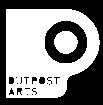LANGHOLM PEOPLE





Langholm Camp Preface - Essay by Sophie Jarzyna
Langholm Camp Commission - Morag Eaton
Langholm in Lockdown
Covid Caring Heroes Commission - Kyna Hodges
Covid Action Heroes Commission - Emily Tough
Community Events Portraiture Competition
Langholm People Project Exhibition

Langholm People Project focuses on bringing awareness to Langholm’s people from history, contrasted with ‘ordinary’ people from present times; drawing parallels between the adversity faced following WWII, particularly the displaced Polish soldiers who were resettled in Langholm Camp, and the collective challenges Langholm’s community has faced during the Covid-19 pandemic.
As part of a national effort to resettle Polish people displaced by war, many Polish soldiers ended up living at Langholm Camp - built on the site of a former military base at Castleholm. Their important stories have yet to be collectively shared, despite the men who settled in the town making an important contribution to Langholm’s community and culture. With those who remember Langholm in the days and years following the end of WWII dwindling, OutPost Arts felt an urgency to gather information, oral history, and imagery, and to create new pieces of work to commemorate these important people and their personal journeys.
Covid-19 struck in early 2020 with a series of lockdowns and restrictions enforced from March onward, profoundly affecting the local community, our country and foreign nations in every conceivable way. The fallout from WWII and the pandemic link Langholm with mass existential crisis - forcing us to confront and question our living spaces, our priorities, our relationships, and our lifestyles in unprecedented ways.
This book documents Langholm People Project’s research and development stages, featuring the results of three artist commissions - Morag Eaton captured the experiences of the Polish men resettled in Langholm; Kyna Hodges created photographic portraits of Langholm’s Covid19 Support Group; and Emily Tough created vibrant models of four local figures who worked tirelessly to serve Langholm’s people during the pandemic.
Langholm People Project is part of OutPost Art’s larger ‘A Creative Place’ project, funded by Holywood Trust, The Robertson Trust and Muirhall Energy.
The exhibition, short film, and book are specifically supported by Langholm Alliance - an organisation established to deliver key aims and objectives outlined in Langholm’s Action Plan for regeneration.
The project’s exhibition featured as part of the town’s 400th Charter Anniversary programme in September 2021 - a series of events and activities coordinated by Langholm Alliance with support from Dumfries & Galloway Council.
OPA background: Established in 2018, OutPost Arts is a contemporary rural arts organisation based in Langholm who connect people and communities to meaningful, high quality and educational creative activities, events and opportunities - promoting creative wellbeing, community resilience, skills development and regeneration.
This page: Marriage of Naomi Tedham & Jan Klaskinski, July 1948. Pictured is Naomi’s father James (bottom left), who was Langholm Camp’s caretaker - courtesy of Stuart Tedham
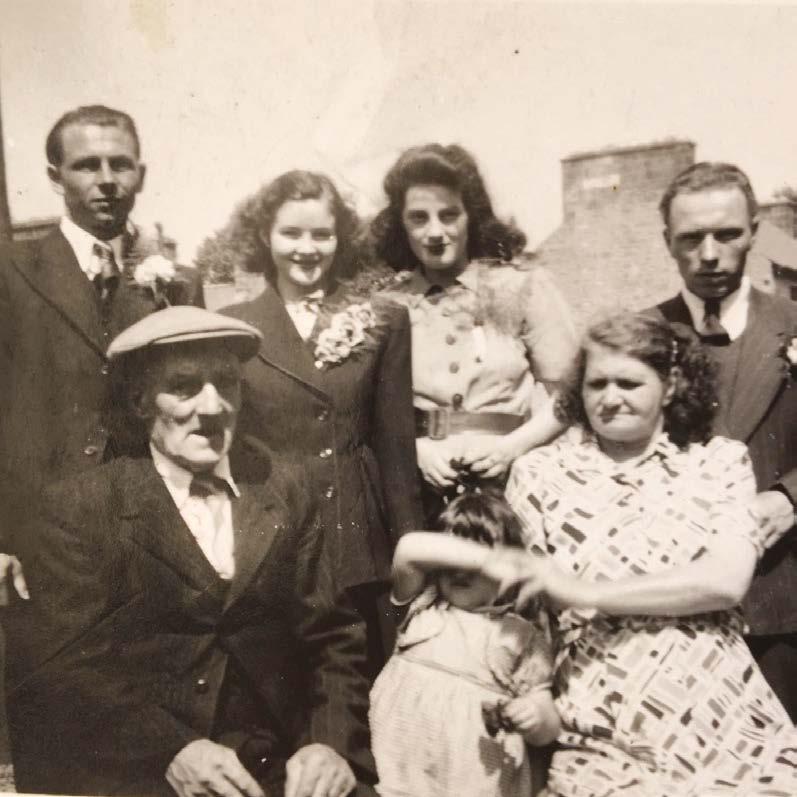
igos - a dish made from stewed Sauerkraut, white cabbage, meat and sausage. The type of meal that comforts you on a cold day, fills the house with its garlicky aroma and something that was oh so familiar to me growing up. This traditional dish hails from Poland - just one of the little things that point to my Polish heritage.
Sadly, I never met my Polish grandfather, Aleksander Jarzyna, but I have always been aware that I am a product, in-part, of survival and of two cultures colliding – of an unthinkable and treacherous journey from Central Poland, through Nazi concentration camps, Italian battlegrounds and eventually to this ‘Wee Bit Toon’ in Scotland.
It is strange to imagine the sight of Sherman military tanks bearing Polish soldiers trundling up the Wauchope Road but, by 1946, Langholm was well accustomed to having military company. The Langholm Camp had trained thousands of troops throughout the war, and boyhood accounts of the time speak of secret missions; gruelling time trials up and down Whita Hill; chunks taken from buildings by armoured vehicles and even wayward bullets finding their way past a housewife minding her own business at the kitchen sink!
Langholm and subsequently assigned work at the Labour Exchange office. The work was focused on forestry, agriculture, and construction – where the men’s strong work ethic was noted by all.
With the Second World War coming to an end, however, the Camp, like hundreds throughout the UK, was utilised as temporary housing for Polish soldiers who had bravely served the Western Allies but were unable to safely return to their homeland. My grandfather was one of many Poles brought to
During downtime there were dances a plenty - a chance for the ‘gentlemanly’ Polish soldiers to take the hand of a local lass and show off, from all accounts, some very fine footwork. This footwork would also be sighted on the football pitch with the Camp reportedly having their own team. Unfortunately, there are few records surviving of
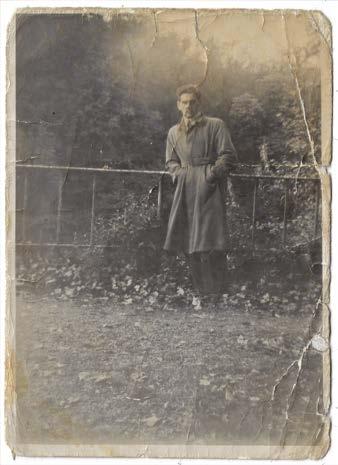
the camp itself, but early memories shared by some of the men’s offspring, are filled with warmth. They remember being shown off with pride at the Camp, dressed in their Sunday best, spoiled with sweeties and warmed by the small stove that would be found in each Nissen hut dwelling.

In time the Poles became woven into the fabric of the town - there was Bortko making the shoes and Joe Zemla cutting the people’s hair - while others brought extra skill to the booming textile trade, even initiating the nightshifts to meet growing demand. There was a comradery in the mills that would spill out into pubs, not to mention the parties and weekly socials where a ring of Polish sausage would be shared amongst the men, undoubtedly washed down with a vodka or two.
While there was clearly joviality at these gatherings, sometimes I wonder what they would talk of between themselves. Did they reminisce about their homeland and the family they were sadly separated from, or the horrendous events they encountered during the wartime? The integration of the Poles was not always plain sailing, but in my search to find out more about the post-war Langholm I have been warmed to hear the Poles being described as ‘canny men’ or ‘assets to the town’ and that the ‘new blood’ was welcomed and continues down through new generations.
Born in Langholm, after attending university in Edinburgh and then working in London, Sophie Jarzyna returned home to develop a professional ceramics practise and studio. In 2020 Sophie was awarded an Emerge bursary from regional arts & crafts organisation Upland CIC.
Left: Aleksander Jarzyna on Duchess Bridge, courtesy of Stella Tait Above: Stanley Scezchek, courtesy of Steven Jarzyna
Left:
Above:
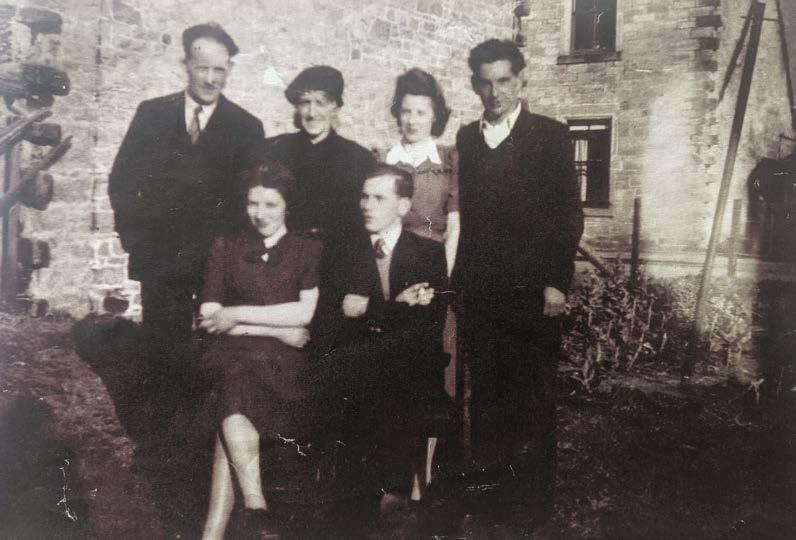 Poles on Duchess Bridge, courtesy of Stella Tait
Poles on Duchess Bridge, courtesy of Stella Tait
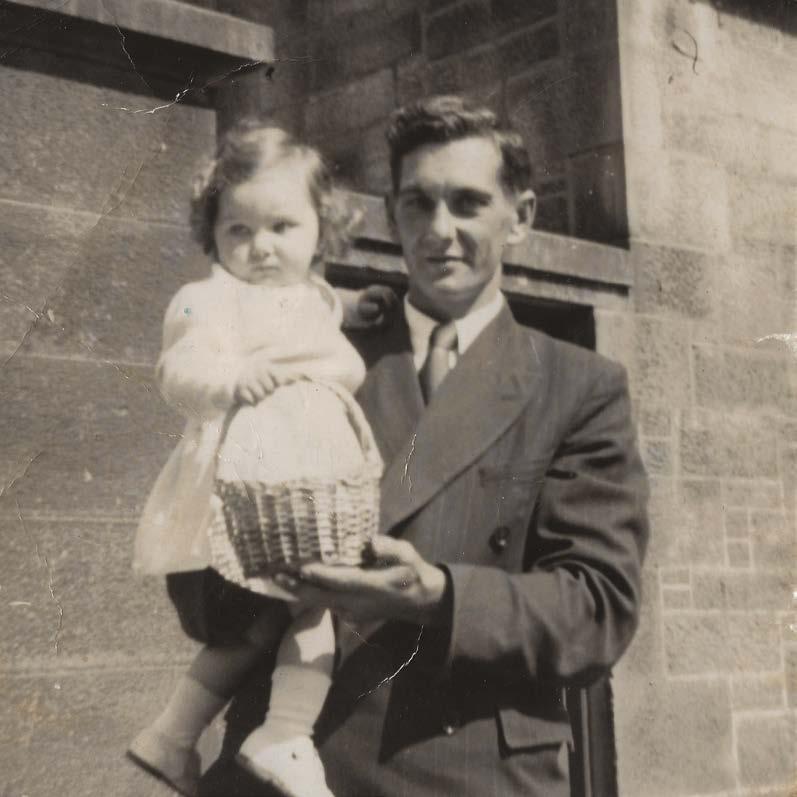 This page: Aleksander Jarzyna with his daughter, Stella Right: Olek Jarzyna (middle) with unknown friends - photos courtesy of Stella Tait
This page: Aleksander Jarzyna with his daughter, Stella Right: Olek Jarzyna (middle) with unknown friends - photos courtesy of Stella Tait


The political settlement between Roosevelt, Stalin and Churchill meant that when the war ended the Soviets annexed Eastern Poland and incorporated it into the Soviet Union while the rest of Poland became a puppet state with a communist government imposed by Russia. Most Poles rejected this settlement and chose to remain in the West where they could continue the political struggle for an independent Poland while maintaining their language, culture, and traditions for an eventual return to their homeland. Some 250,000 chose to remain in Britain and were joined by their families and dependents from wherever the fortunes of war had left them. By far the largest number were those who, having escaped from Siberia with the Polish Army in 1942, had spent the war in camps set up by the British in India and West Africa.
the National Service Hostels Corporation being the principal ones. There were many such camps in the UK - most built in the early 40s in rural areas, often in the grounds of large country estates, as military hospitals, army bases and airfields. During WW2, Castleholm – now commonly utilised as a picturesque place for walkers, a well-used cricket ground and a grazing site for sheep and cattle – had become a large-scale, busy military base for allied troops. Following the war, like many similar sites across the Borderlands, it was adapted to re-settle Polish ex-servicemen who were unable to return home. Exact numbers resettled at Langholm Camp are difficult to source, but the 17th of Nov 1946 edition of The Sunday Post reported –
Recognising the Polish contribution to the Allied effort during the war, which included Poles flying in the Battle of Britain, fighting at Monte Cassino, and breaking the early Enigma codes - displaced servicemen were allowed to find a new life in Britain. Many thousands started this new life in Polish resettlement camps. The only way such numbers could be accommodated was by placing them in camps recently vacated by the Americans and Canadians. A Polish Resettlement Corps (PRC) was raised in 1946 as a corps of the British Army into which Poles were enlisted for the period of their demobilization up to 1948. The camps in the UK were given up by the MOD to house Polish Families and they were administered by several organisations; National Assistance Board, Local Authorities and
‘One thousand two hundred Poles and their dependants from the Polish camp at Barrow Head, Wigtownshire, are coming to Langholm, Dumfriesshire.’
There are few pictures of Langholm camp, but we know that accommodation consisted primarily of Nissen huts – which, despite having electric lights, had poor ventilation and little natural light. What remains of these huts can still be seen when walking around Castleholm.
The Polish servicemen and their families, many of whom settled permanently in the town, have become an important part of the rich fabric of Langholm’s culture, yet only anecdotal evidence of their important contribution to the town has collectively been shared - until now.
Right: Similar Nissen huts at a Polish resettlement camp in Bottisham, Cambridgeshire

Bottom Right: Artist Morag Eaton
This project allowed OutPost Arts to engage with existing descendants and local people in order to capture and share memories, stories, experiences and personal archives and use creativity to connect them to the wider community. We particularly wanted to share the commissioned artist’s research and final pieces of work with the community to inform, educate and inspire modern generations - allowing them to consider issues surrounding displacement in a context they could personally relate to.
Over several months, artist Morag Eaton met with and spoke to several key stakeholders relating to Langholm Camp, including living relatives of Polish servicemen who settled permanently in Langholm. Morag’s research work was supported by Sophie Jarzyna, who carefully and sensitively reached out to relatives and other contacts, gathering documentation, images and crucial information.
Morag Eaton is an established Printmaker based in Berwick-upon-Tweed. Not one to be pigeonholed, Morag has previous experience in a variety of creative sectors including time spent as a management committee member for Northern Print in Newcastle-upon-Tyne, a product designer for Shell, British Airways, Rolls-Royce and a college lecturer.
A lifetime of involvement in both commercial design and fine art printmaking culminated in a move to the Scottish Borders in 2010, allowing her to pull all her skills together. Morag particularly finds inspiration in narratives, particularly tales of superstition and magic that flourish in the region.


Living relatives of Polish serviceman Michael Oiciak kindly allowed Morag and Sophie to access his personal archive of documents, family photographs, IDs, certificates and interesting objects. The box’s contents told the story of family left behind, his journey to Scotland through various countries, and the experiences he faced whilst in Langholm, such as registering to work.
For greater context, Morag visited the vast Eskdale & Liddesdale Advertiser archive to gain insights into life in post-war Langholm, the camp and the Polish servicemen themselves. An in-person visit to Castleholm, where Langholm Camp once stood, allowed Morag to get a sense of the day-to-day experience of life in the camp - an open, peaceful greenspace, surrounded by hills and woodland. Steven Jarzyna, son of one of the Polish servicemen guided Morag around the area, pointing out where facilties were located, alongside personal family tales, providing a sense of scale and detail.
In early July 2021 descendents and Langholm locals with childhood memories of the camp met with Morag at the Eskdale Hotel to swap stories and memories over cups of tea and cake; many bringing photos and other items to reference. From these conversations, experiences, and reference materials came the ideas for Morag’s final work - a triptych of prints and an accompanying voice and music soundscape that capture ‘cultural exchange’. These pieces of work were shared alongside outputs from two smaller artist commissions, and the community activities in a large-scale exhibition, which formed a key part of the town’s official ‘400th Anniversary’ celebration programme in September 2021.
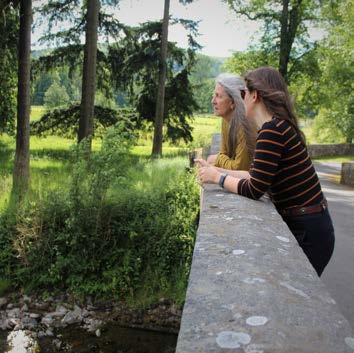
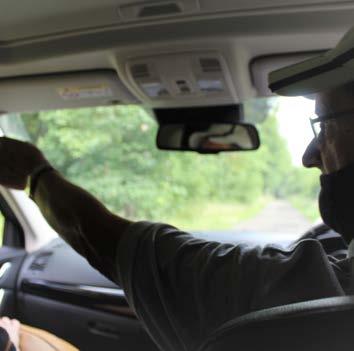 Left: Michael Oiciak’s case with personal documents, photos and mementos
Left: Michael Oiciak’s case with personal documents, photos and mementos
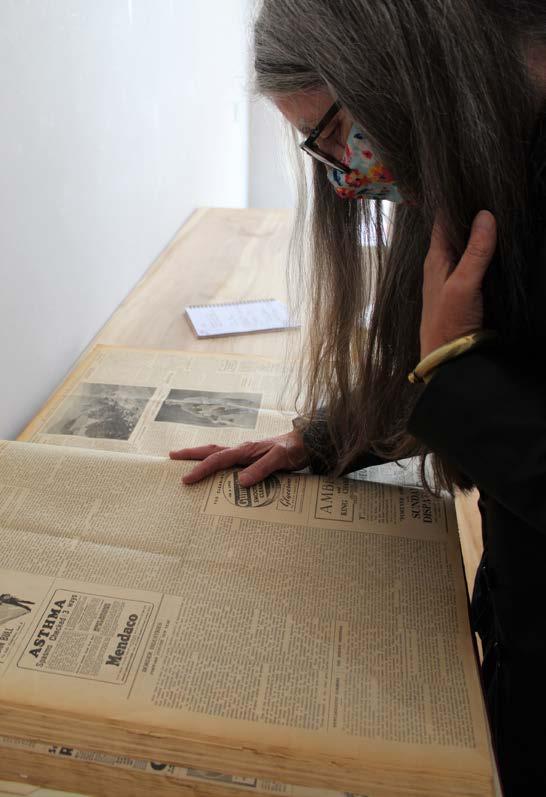
Left: Morag looking through the Eskdale & Liddesdale Advertiser’s vast newspaper archive
Above: Barbara at work on the commission in her BerwickUpon-Tweed printing studio
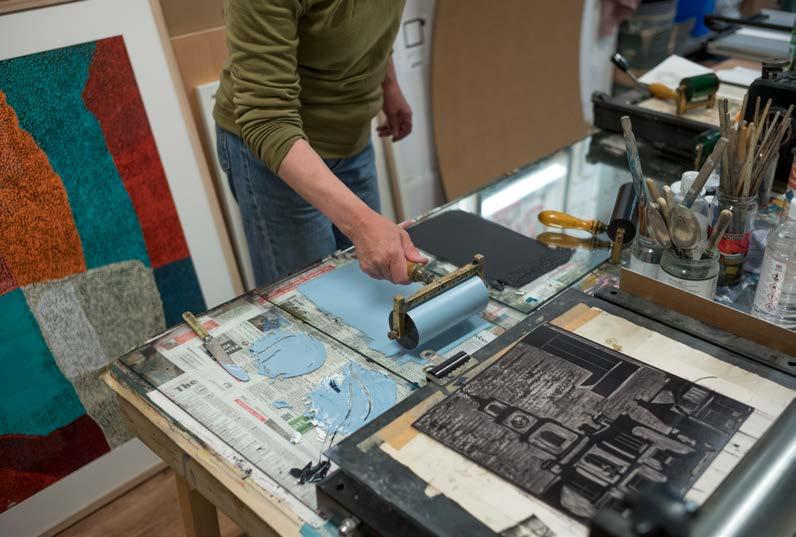
Above: Morag’s ‘L for Langholm’ linocut print Right: A contrasting ‘Urban Rural’ linocut depicts the servicemen’s homeland with national emblem - the white eagle
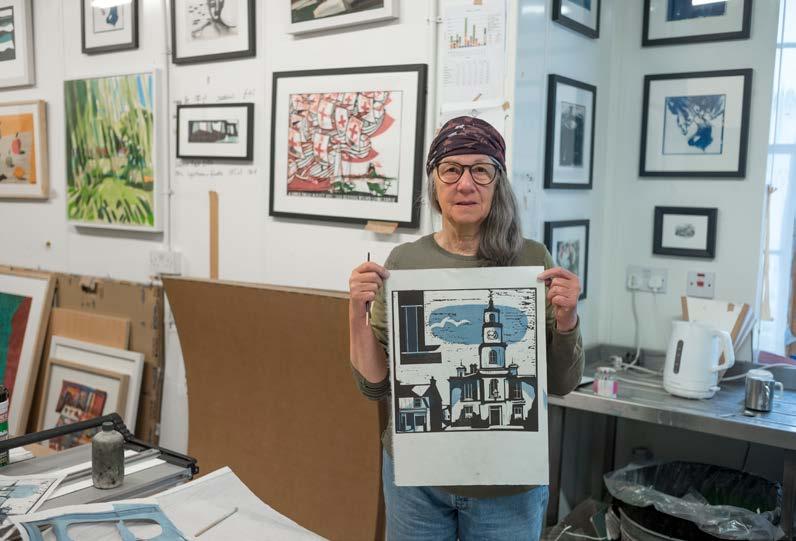
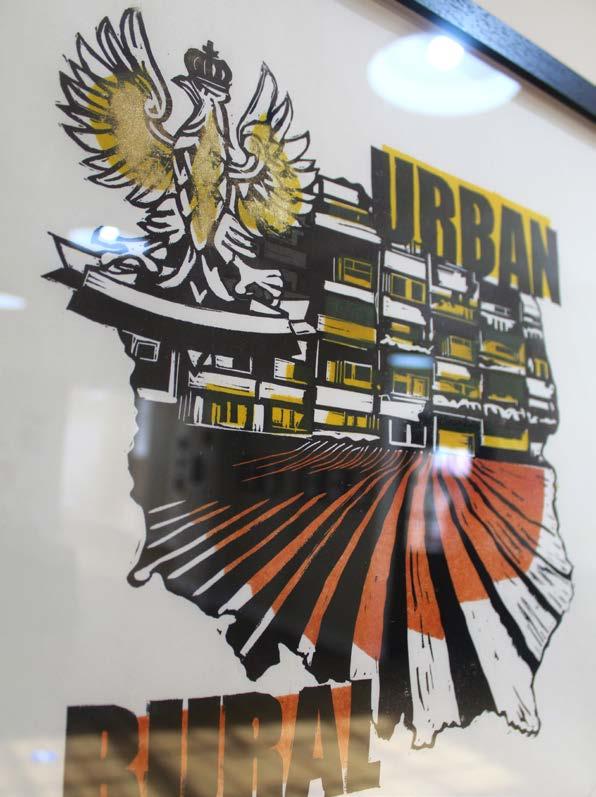

(Left) Morag’s central piece of work - a large-scale A-Z relief print illustrating the Polish servicemen’s experiences, incorporates local, Scottish and Polish cultural symbols.
Below: The print’s ‘key’
Accordian
Buccleuch Centre Comradship
Dominoes
“... playing dominoes with Stanley”
European Union
Football
“... he played goal for Canonbie”
Gentlemen
“... they would kiss your hand” Hospitality
Italy Monte Cassino
Jive
Kielbasa (smoked sausage)
Langholm
Muckle Toon
Narod Polski (Polish nation)
Orgorki Kiszone (gherkins in vinegar)
Pierogi (filled dumplings)
Quality
“Europe was hungry for quality goods”
Rollmops
“... a sweetie jar of rollmops”
Sweets
Textiles
Uwaga Drzewo! (English: Timber!)
Vodka
“... a bottle of vodka would last all night” Woodsman
“... he was in the forestry...”
X for St Andrews flag
Year 2021
Zurek (a Polish soup)
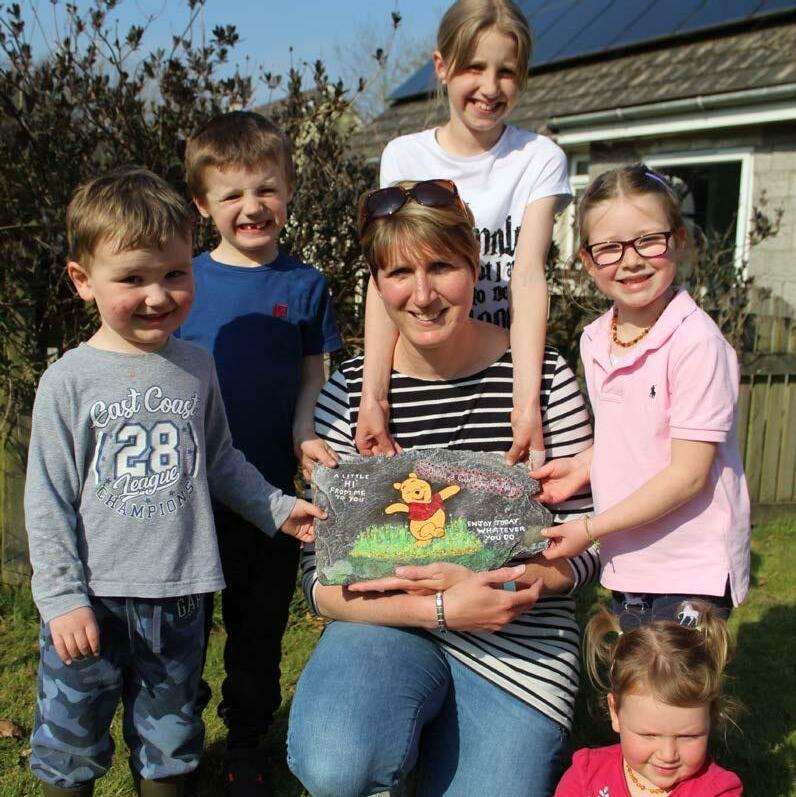
During lockdown, a simple and generous action by one local young person - morale-boosting painted stones - led to a raft of kind-hearted ‘community artists’ peppering local services, shops, streets and houses with similarly vibrant and uplifting decorated stones with bespoke messages. OutPost Arts documented many of these stones, held by the people they were made in support of; creating a poignant portrait of the local community in lockdown.







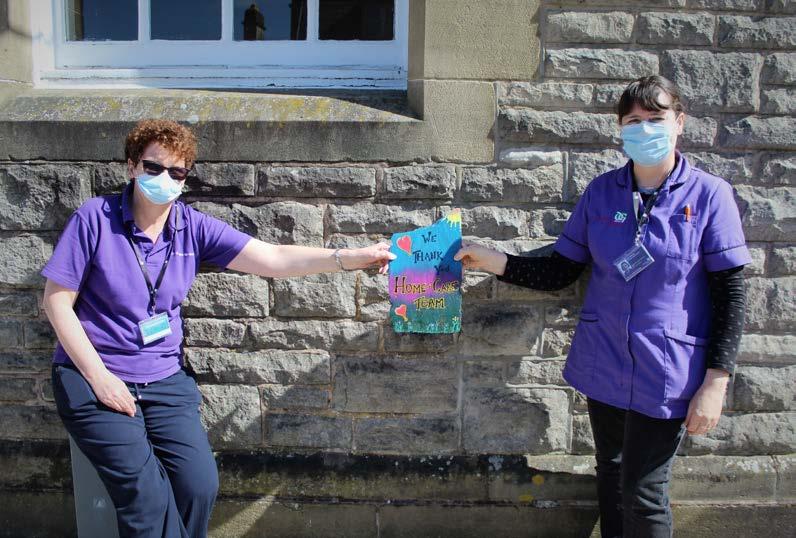





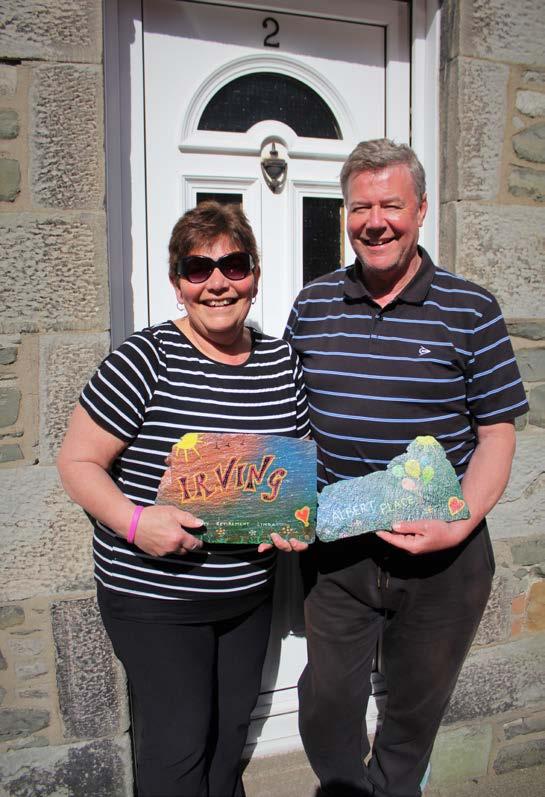
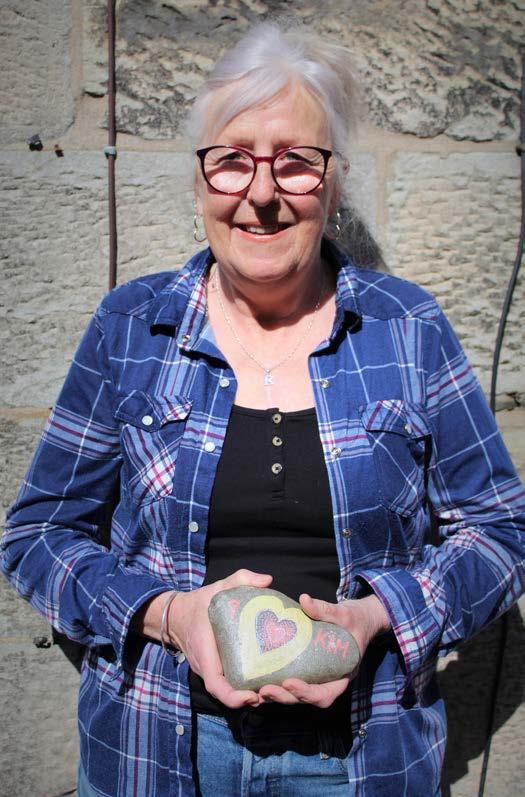
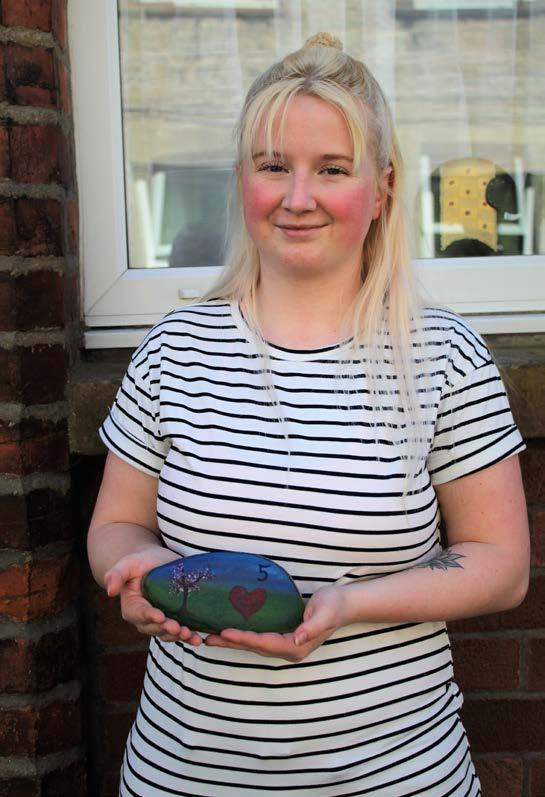
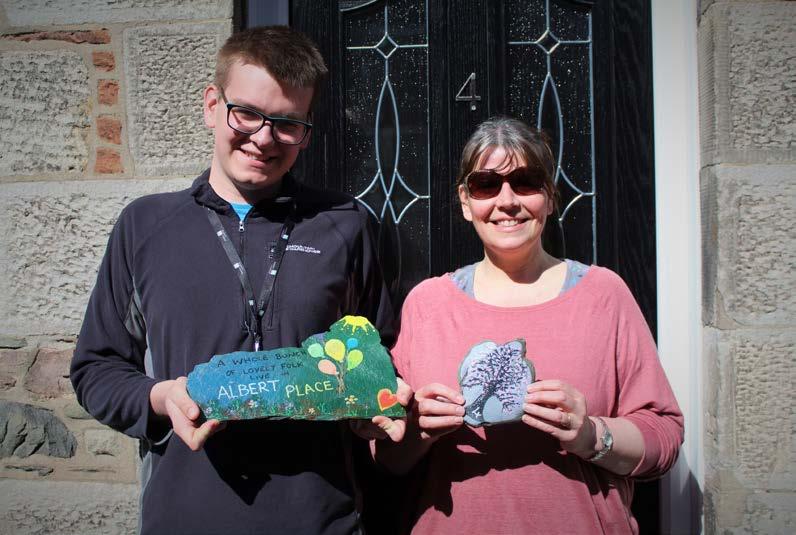


s a direct response to Langholm’s lockdown a group of local women established Langholm Covid19 Support Group - leading a widereaching Facebook and flyer campaign which triggered a large-scale response from local people anxious to help. The Facebook page became a focal point for Covid-19 related issues affecting the community, allowing people to air concerns, share information, and receive advice and support.
Choreographed by the support group, volunteers responded to ‘shout outs’ from local suppliers via Facebook and a delivery protocol was formed to en sure the process was as safe as possible for everyone involved. Volunteers also supported vulnerable residents on the telephone to prevent isolation and
minimise anxiety - lending a listening ear and com pany when needed. Vouchers were also distributed by the support group to give local people struggling to make ends meet a financial ‘helping hand’.
The Covid Caring Heroes commission honours the four local women who formed the support group - recognising their efforts through portraiture; focusing on their humanity in the face of adversity. The process the commissioned artist usescreating an immediate result - allowed the women to feel a part of their own portraiture process.
The commission also engaged younger generations of Langholmites, providing an opportunity for young people graduating from Primary to High School at a most turbulent time, to create their own visual record of this moment in time via photography.
Kyna Hodges is a multi-disciplinary artist working with photography, sculpture, connection and collaboration, primarily focusing on empowerment and the environment. Kyna is one of Scotland’s only female ‘wet plate collodion’ photographers using the time consuming and physical Victorian process. Kyna has always been fascinated by beauty, creativity, and intensity, fostered by her time growing up in an artist community in South West Scotland. After graduating from Glasgow School of Art in 2017, Kyna received a 6-month emerging artist bursary from Upland CIC to develop her professional art practice with mentoring and an exhibition, and continues to explore identity and empowerment through her ongoing practice.
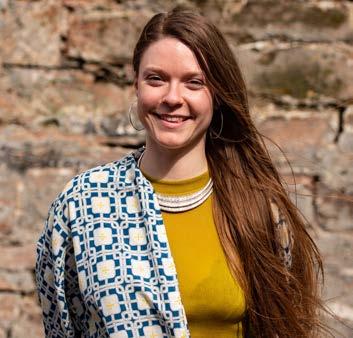
In September 2021, Kyna visited Langholm Primary School’s P7 class, leading a fascinating, handson photographic portraiture workshop. Kyna first explained her process, followed by an introduction to cyanotype-making - a contact print made by exposing UV reactive chemicals to sunlight.
Using pre-prepared negative prints of the pupils from a previous visit by OutPost Arts, the class added local leaves and foliage to create unique collage portrait compositions. Each pupil created two self-portraits, and a selection were displayed in the project’s final exhibition.

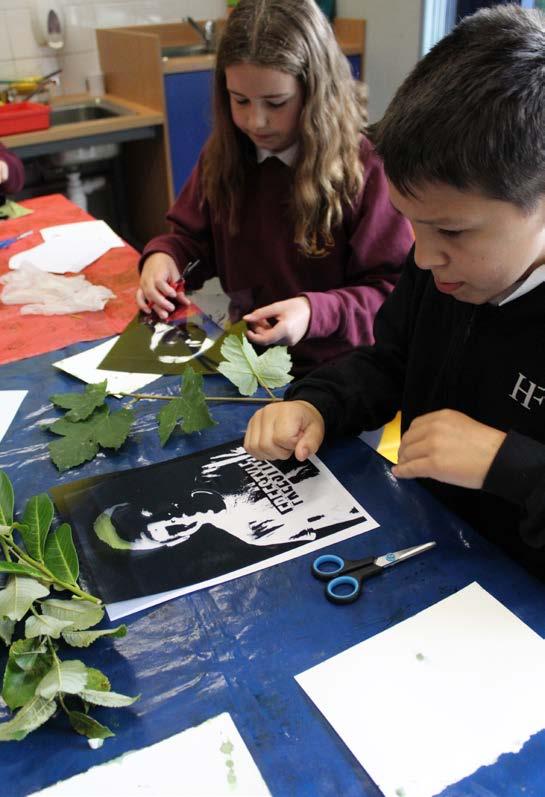
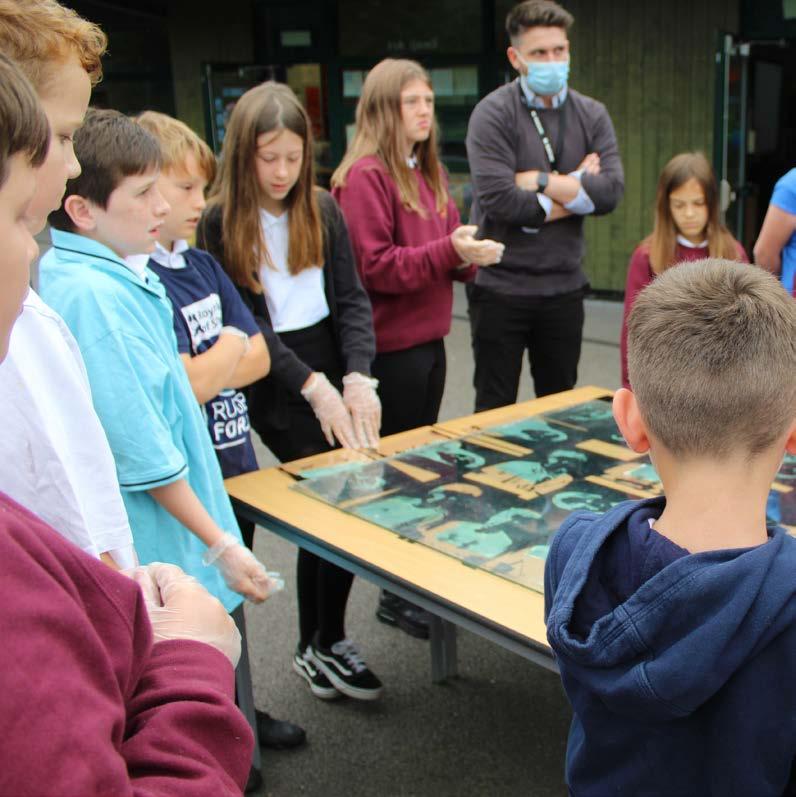


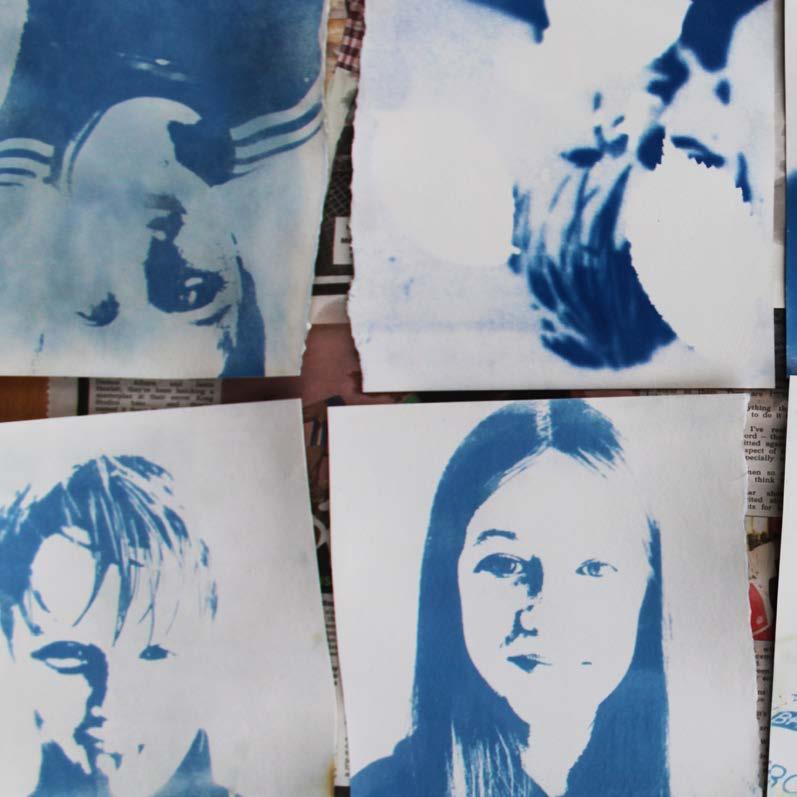
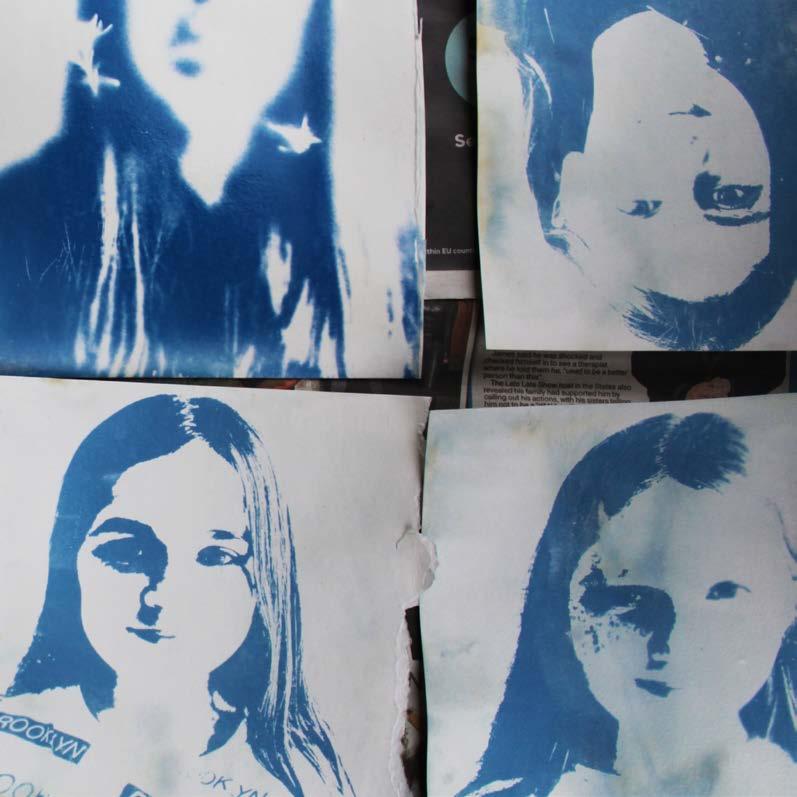

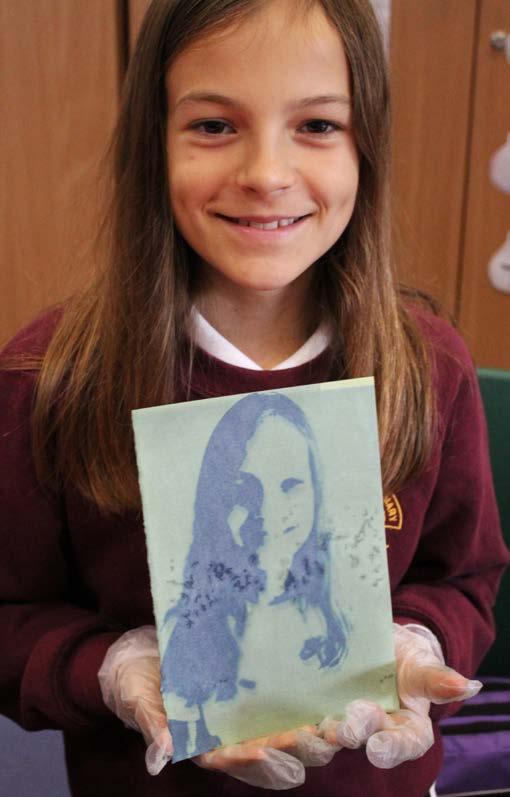
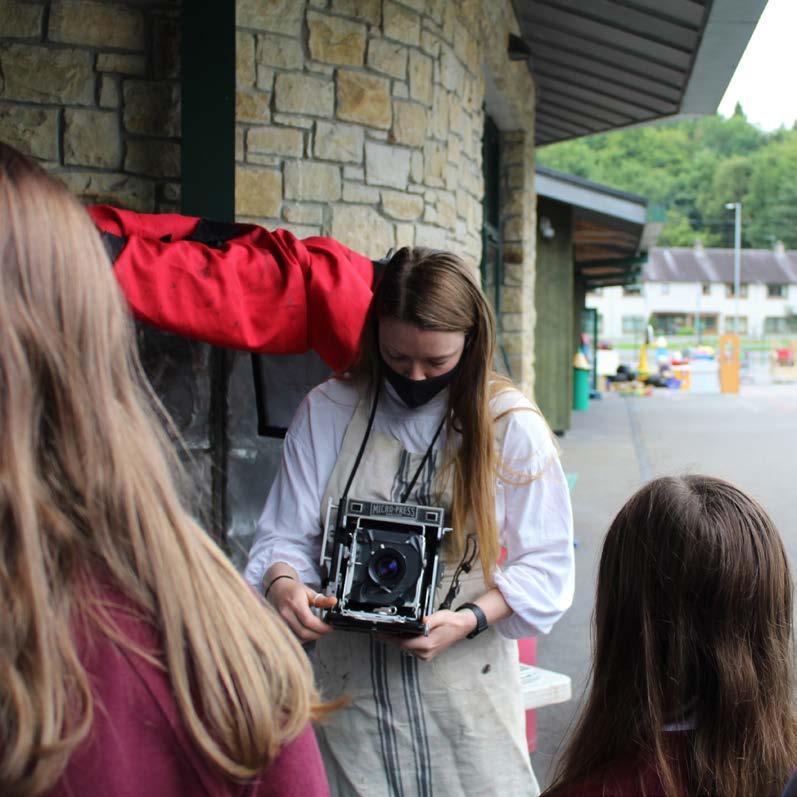
Following the cyanotype workshop, the P7 class gathered to learn more about Kyna’s wet plate collodion process, examining her camera. Kyna then photographed the class to commemorate their important contribution to Langholm People Project.
The group were amazed as, after Kyna disappeared into her pop-up darkroom, an image of the class ‘magically’ emerged in front of their eyes. Lastly, she demonstrated the final process - drying and varnishing the plate to preserve it.
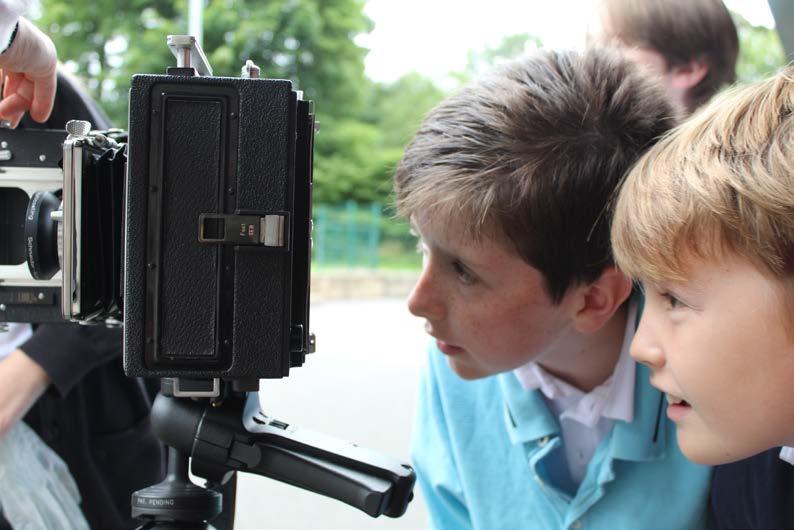
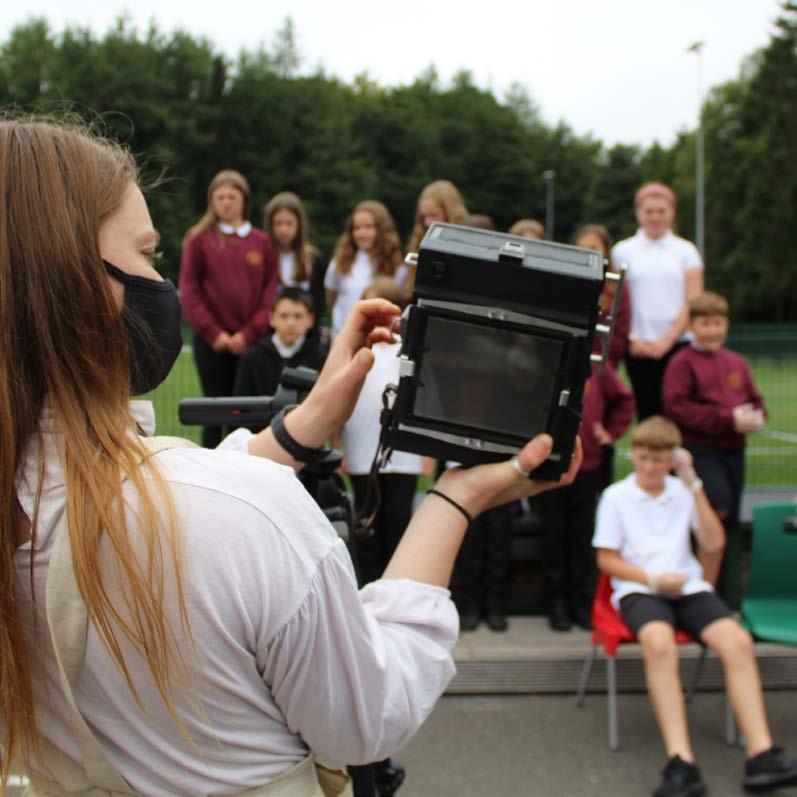

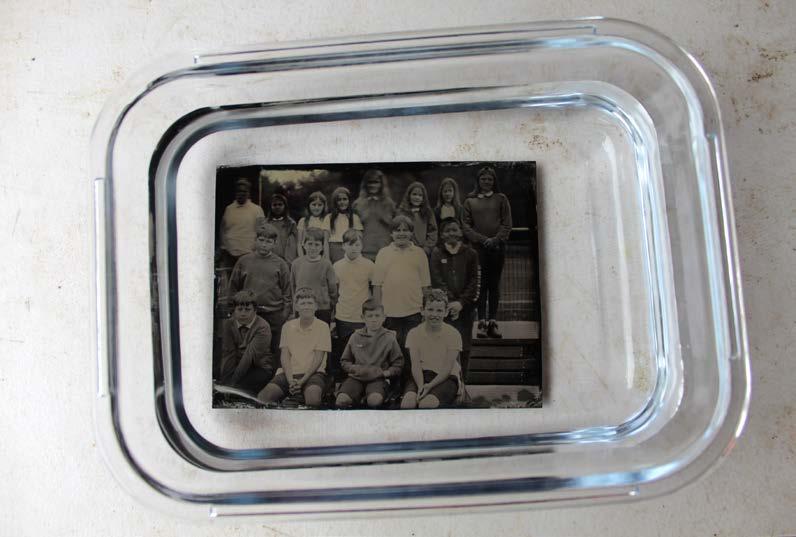

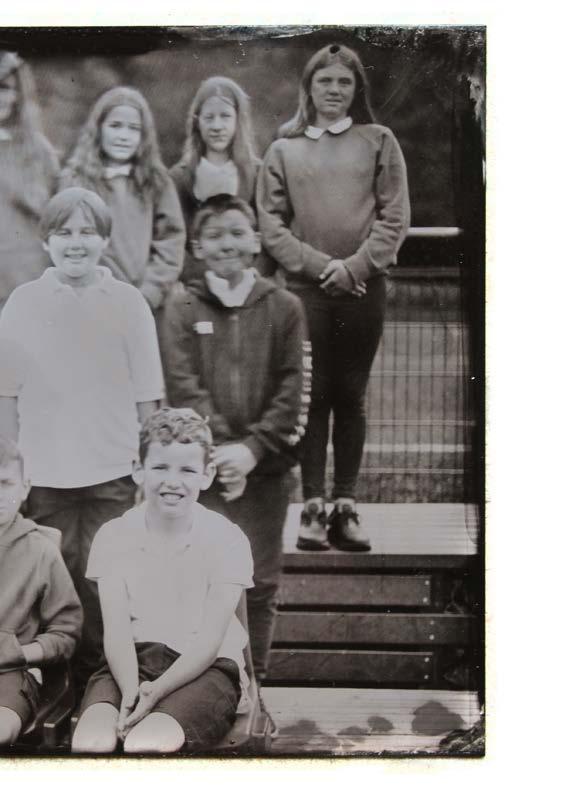
Utilising Walled Garden Arkleton’s glasshouse as a temporary studio, Kyna invited our ‘Caring Heroes’Sharon Tolson, Lawrie Baxter, Kerry Hinds, Sue Toon & Margaret Railton - who established Langholm’s Covid19 Support Group, to sit for formal portraits using her signature wet plate collodion process. The sitters were asked to bring along mementos that represent something meaningful to them, as symbols of their caring natures.
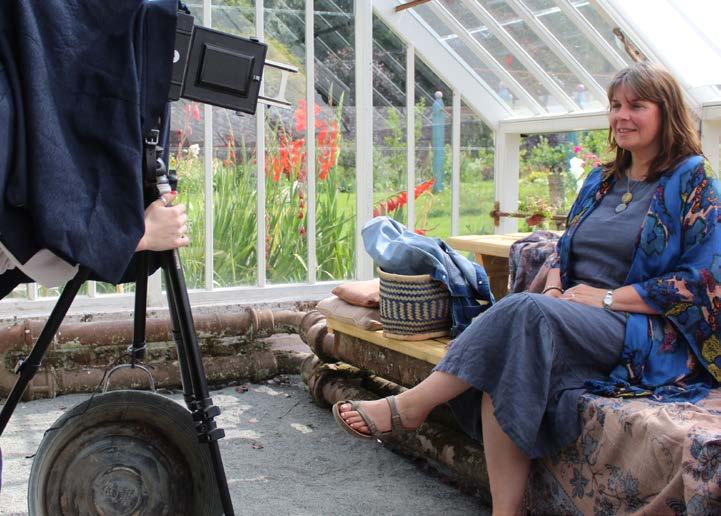
Over the course of a day Kyna took several photographs of Sharon, Lawrie, Kerry, Sue and Margaret in variety of situations and poses. Five were then selected for public display in the project’s exhibition. The show’s preview evening saw them meeting collectively in person for the very first time.
Above: Sharon Tolson is photographed alongside images of her younger brother Ian, (Right) who passed away tragically young.

Sue Toon brought along a small, blue rubber duck, which featured in the background of her portrait. The duck named ‘Oink’ was a much-loved gift from Sue to her late father, who had stored it in each car he
owned. In homage to her father, Sue has repeated this tradition, with Oink becoming a consistent passenger in her own vehicles.

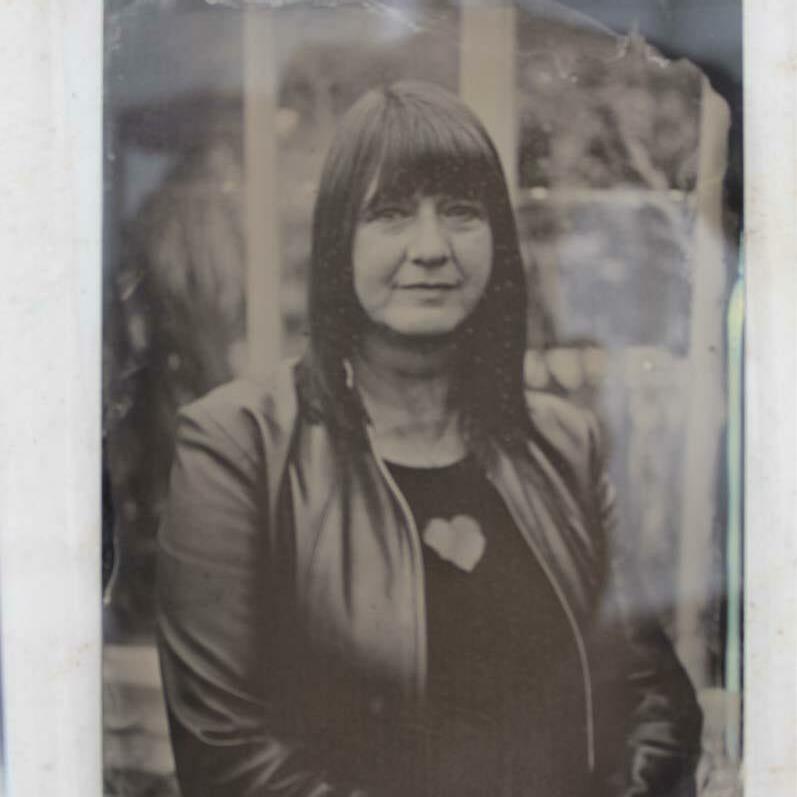
Lawrie Baxter established Langholm’s Covid19 Support Group during the first lockdown in 2020, despite shielding herself. For her portrait, Lawrie brought along a book which held a special, personal meaning to her.
Right: Lawrie’s portrait emerges after the plate was immersed in the developer solution


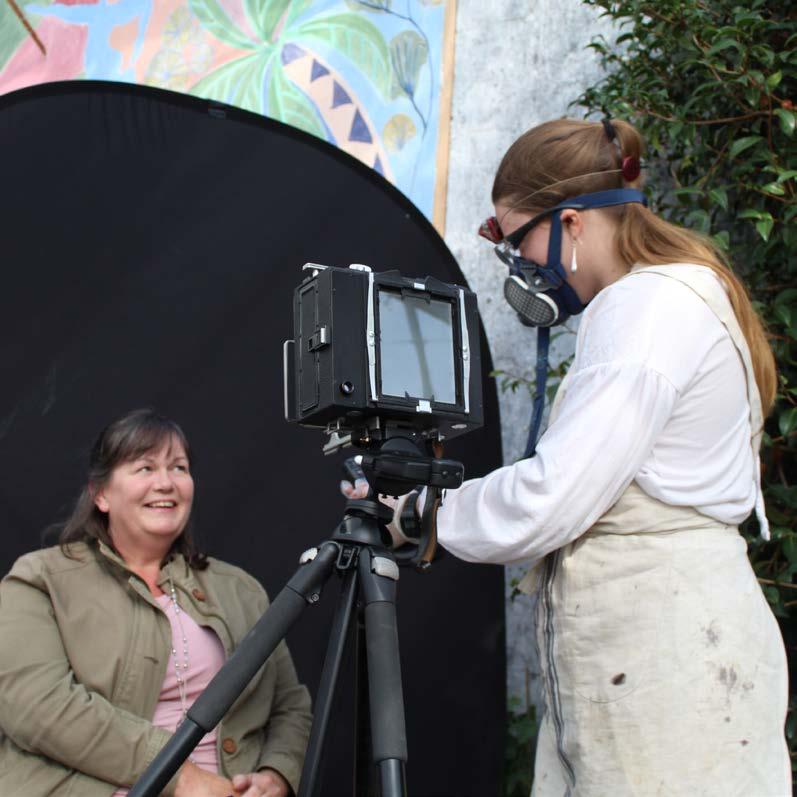
Margaret Railton brought along her Nana’s charm bracelet, which has special associations - she always admired it growing up, and after her passing, the bracelet was passed down, through her mother.
Above: Wet plates showing portraits of Lawrie and Margaret dry after being developed in Kyna’s mobile darkroom
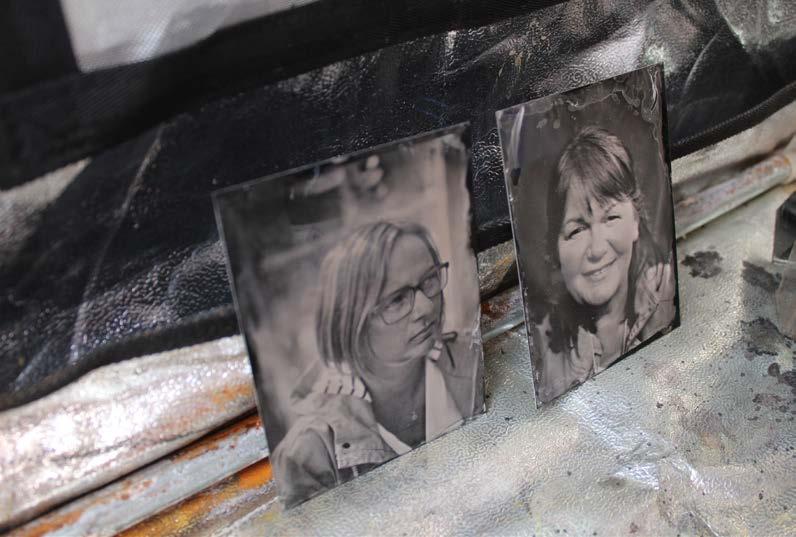
Kerry Hinds brought along a decorative, hanging turtle dove for her photo-shoot. When her close friend became ill with cancer, Kerry bought two turtle doves, giving one to her friend and keeping the other as a special token of their enduring friendship.
Right: The final portrait of Kerry Hinds Page 77-80: Final portraits of Lawrie Baxter, Sharon Tolson, Sue Toon and Margaret Railton
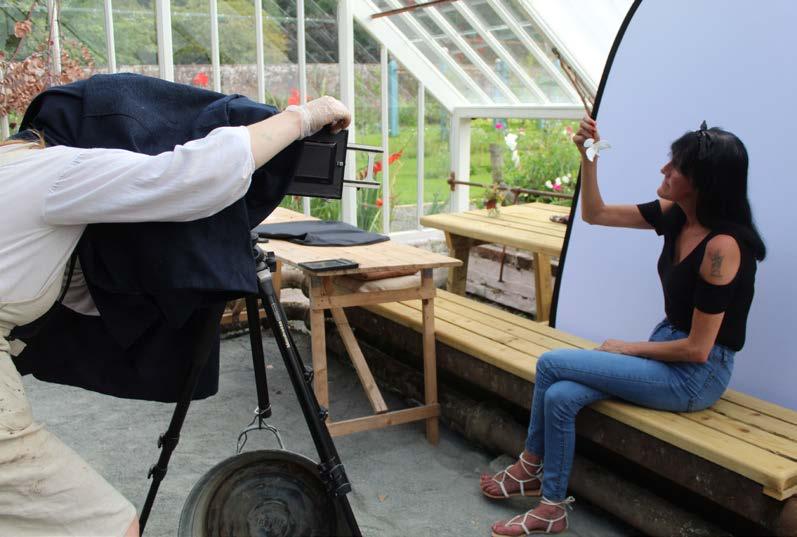
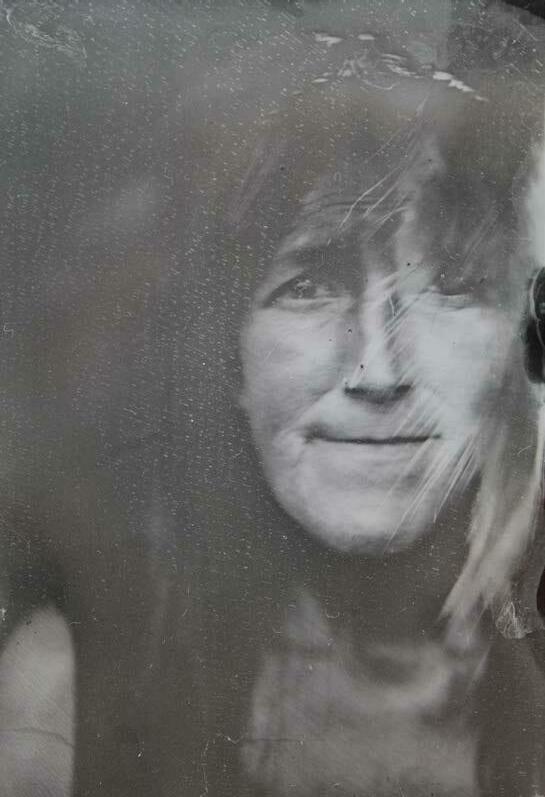


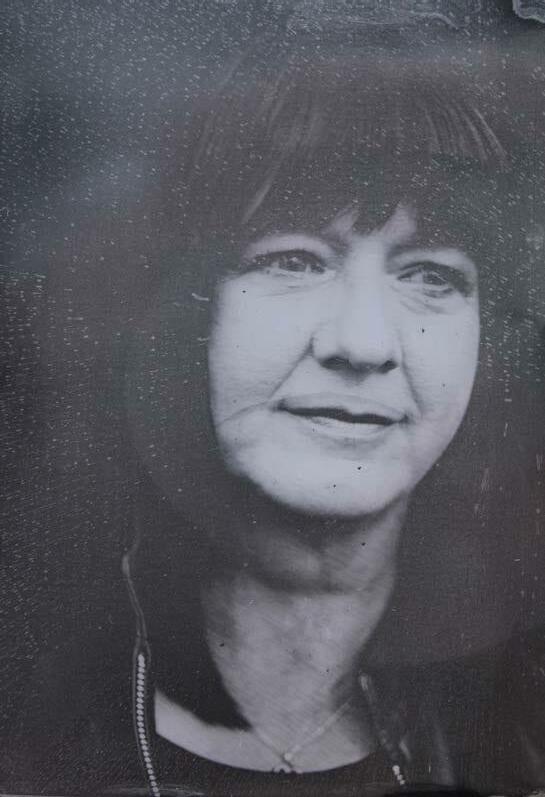


Focused on characterising local people who supported their community at one of the most difficult times in recent history through their actions, artist Emily Tough was commissioned to create unique models of four locals - Gary Collins (local manager of Co-op Foods), Margaret Pool (chair of Langholm Alliance and local organiser), David Brown (butcher), and Amanda Crossan-Brown (co-owner of Brown’s Family Butcher).
During the pandemic, all four Covid Action Heroes went over and above to meet the needs of local people - organising food and dry good supplies, facilitating and co-ordinating financial funding for crucial community organisations, and the creation of public displays to bring cheer to the High Street.
As the project aimed to connect generations, past and present, part of Emily’s commission featured a participatory workshop at Langholm Primary School. During a morning session with the Primary Six class, the cohort were immersed in Emily’s creative world. The class first learned about Emily’s background including her journey as an artist, her influences, materials and processes. Inspired by seeing her colourful and cheerful online portfolio, the group set about creating their own characterful self-portraits. Encouraged to use their imagination, and be playful and free with their interpretation of ‘self-portraiture’, the pupils were given large sheets of A1 cardboard, which they used to create line drawings of themselves. After colour was added with paint, and the portraits were cut out (with the help of MANY staff members!), the ‘larger than life’ self-portaits were ‘modelled’ by the pupils in a photoshoot. Photographs from the workshop formed a display as part of the project’s final exhibition.
Emily Tough is a multifaceted artist - adaptable according to project and medium. Studying Visual Communication at Birmingham City University has left her with a strong illustrative style which permeates through her broad range of work from events, performances, and craftwork. Living and working in D&G as a freelance artist and illustrator, Emily is the founder of the collective ‘We Agree on Eggs’ which other Dumfries artists, musicians, writers, activists and theologians orbit.
Page 81: Gary Collins, manager of Co-op Foods
Right: Emily Tough introducing her work to P6 pupils
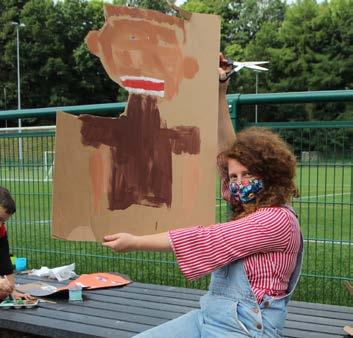
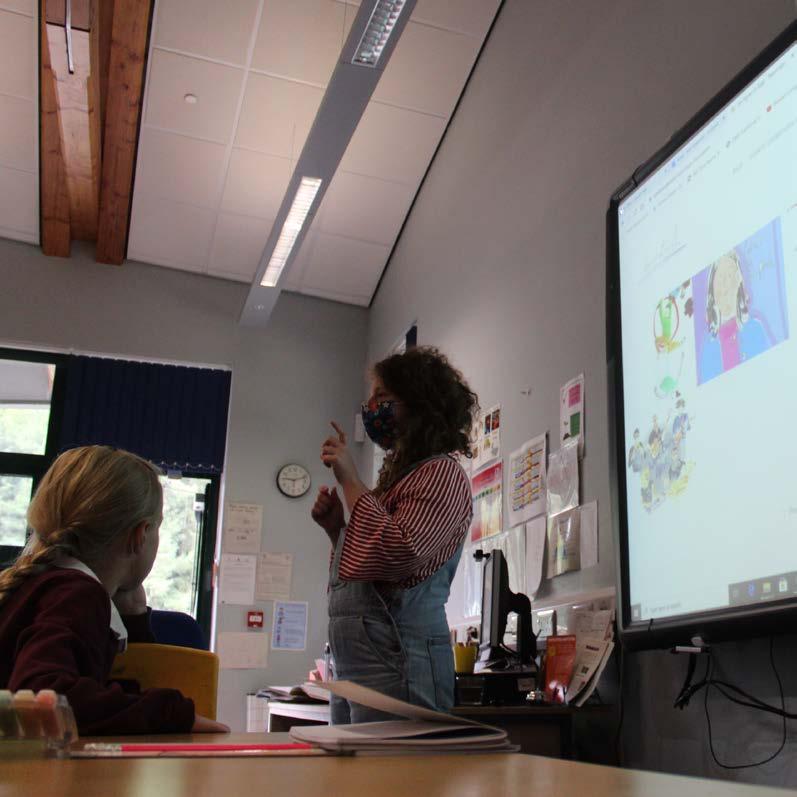
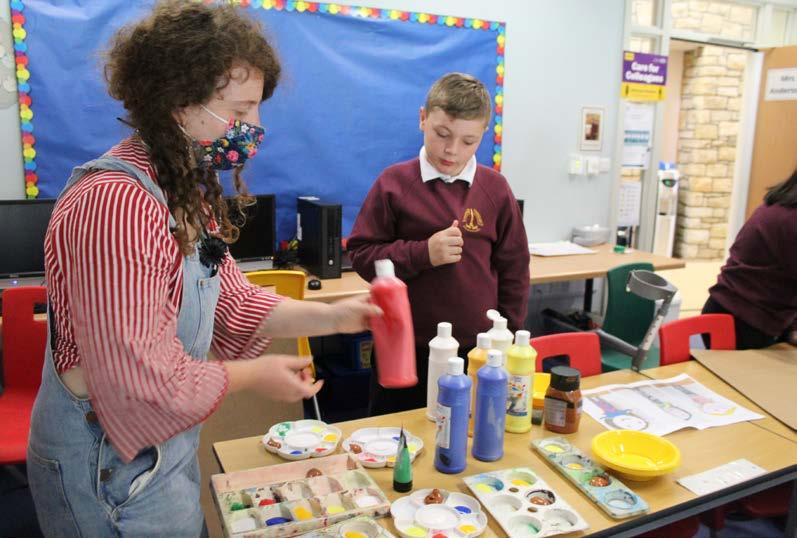


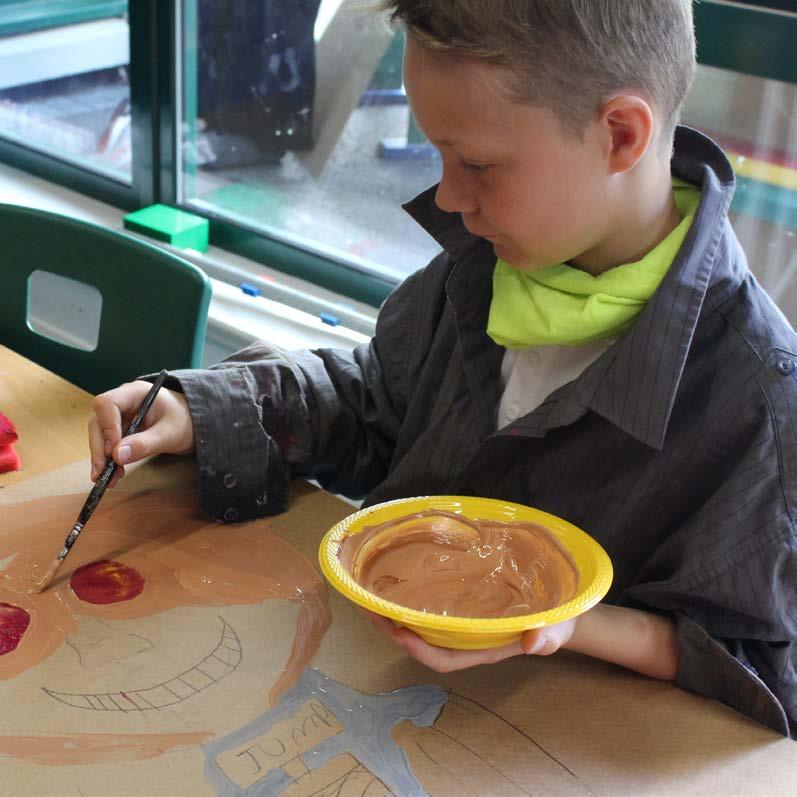



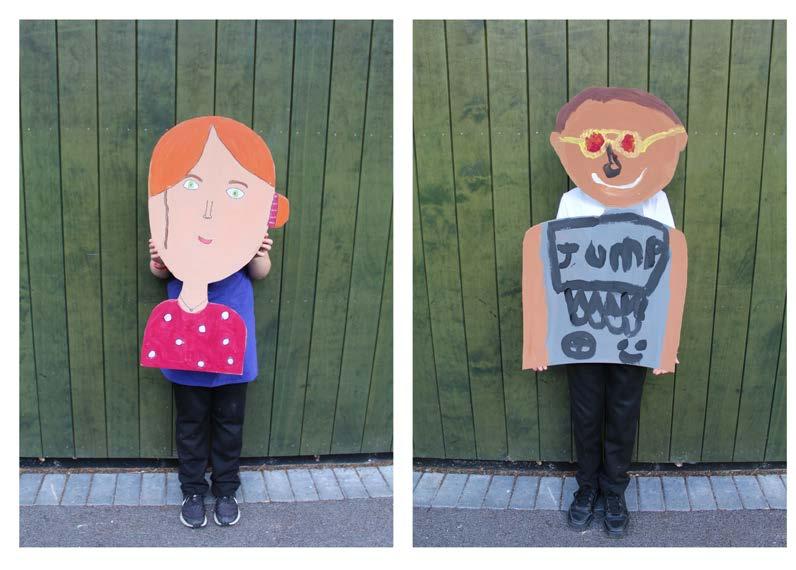

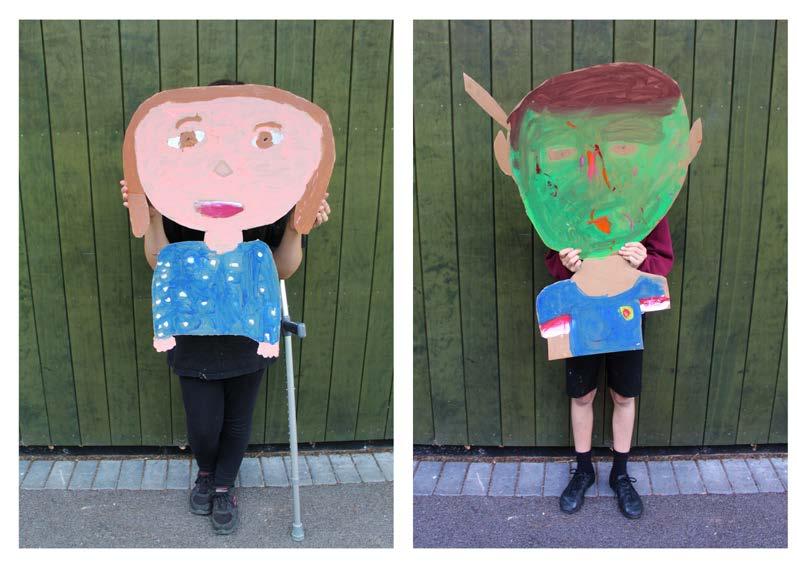


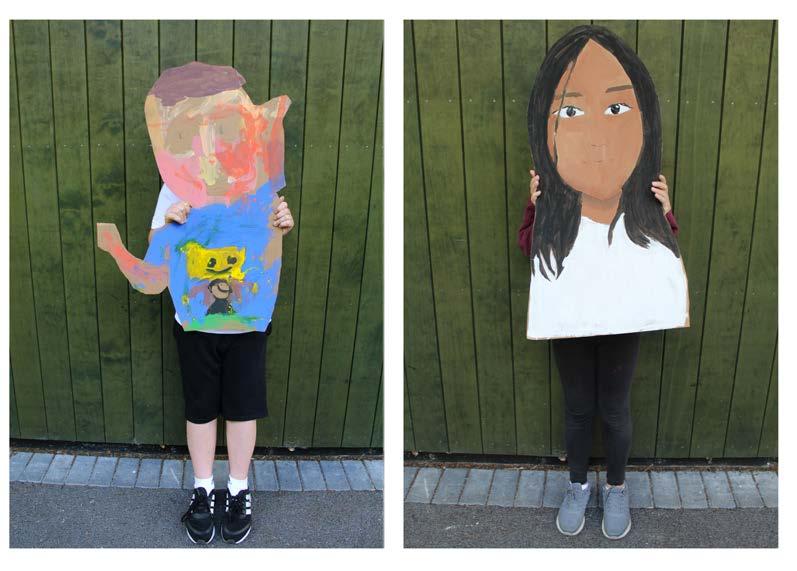
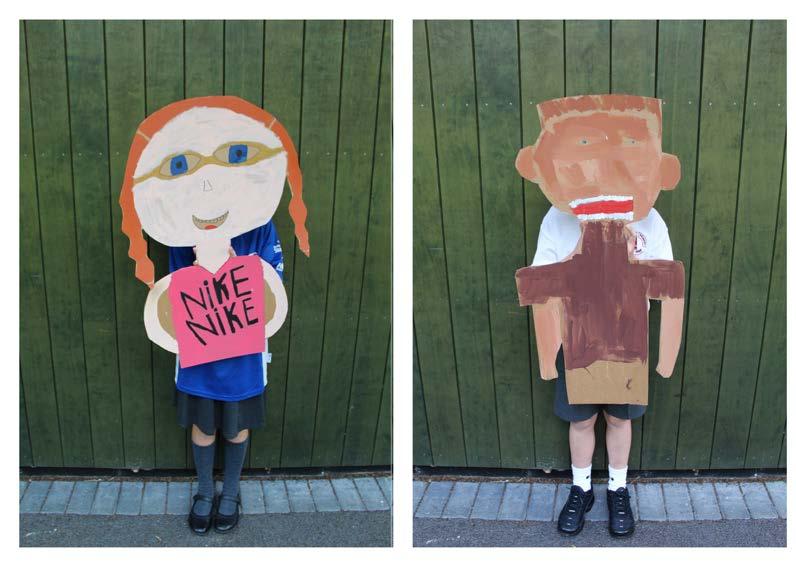




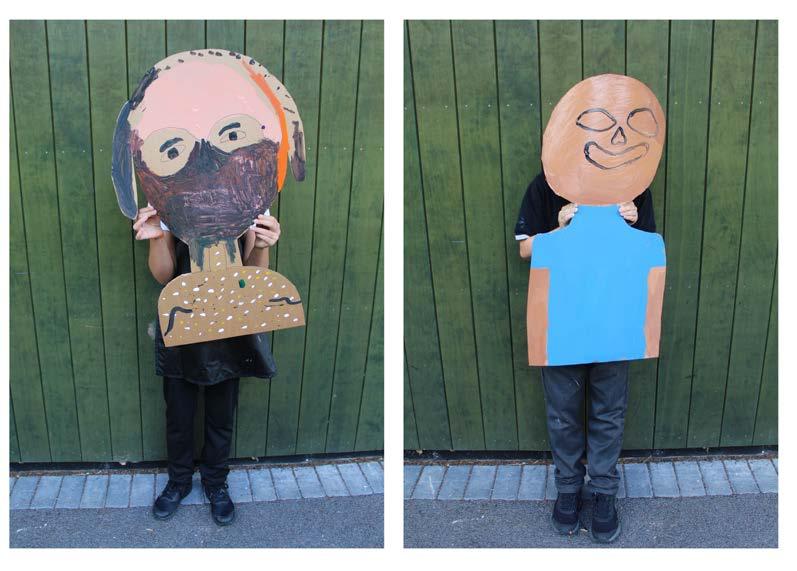
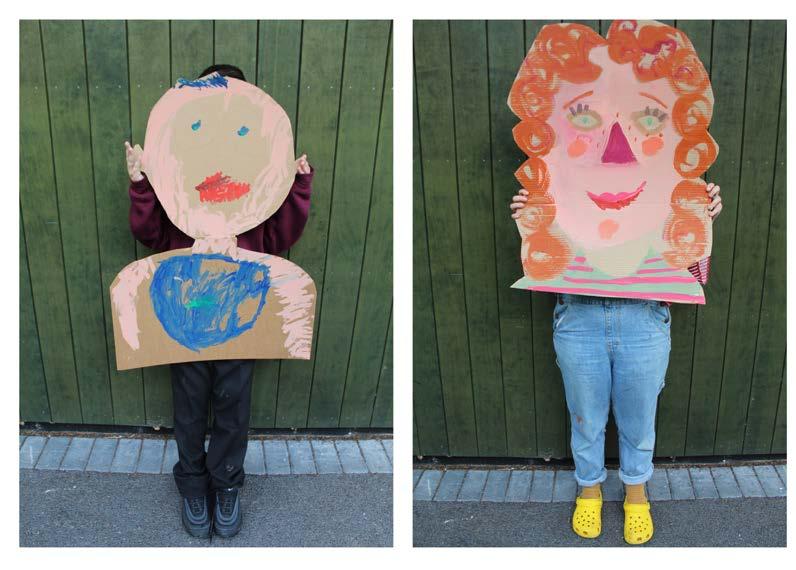
Despite being on paternity leave during the first wave of Covid19, Gary Collins, manager of Co-op - Langholm’s largest general store - worked with local organisers including the Covid Support Group to co-ordinate home deliveries for customers in
and around Langholm. The efforts of Gary and his Co-op colleagues, supported by a number of local volunteers, allowed vulnerable people and their families to access groceries safely and efficiently, reducing anxiety levels significantly.


Margaret Pool is one of Langholm’s busiest residents in her role as Chair of Langholm Initiative - a community development trust responsible for leading the campaign for community-ownership of Langholm Moor (Tarras Valley Nature Reserve).
During the pandemic, Margaret’s actions supported partner organisations and community groups by distributing critical funding. This facilitated a large-scale local response to Covid19, supporting Langholm people’s direct needs.

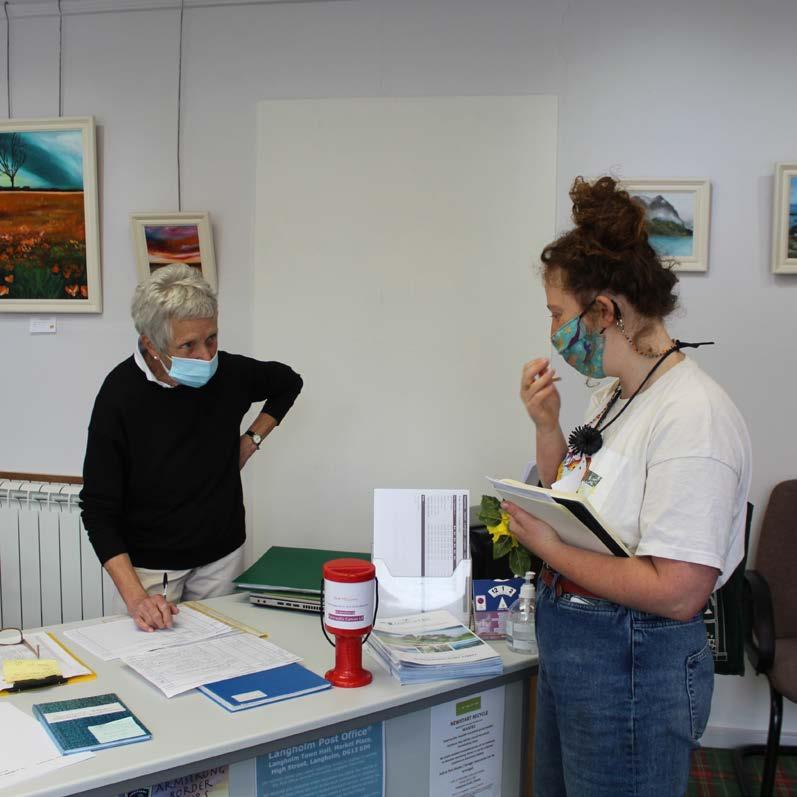
David Brown and wife Amanda established Brown’s Family Butcher in Spring 2020, during the first wave of the pandemic. They immediately responded by supporting people’s needs with telephone orders, free deliveries, and initiatives to reduce waste.
Amanda Crossan-Brown (Right, with Emily) utilised her arts and crafts skills by creating colourful, imaginative and playful shopfront displays to bring much needed cheer to the community - combating the anxiety and depression that many residents felt.
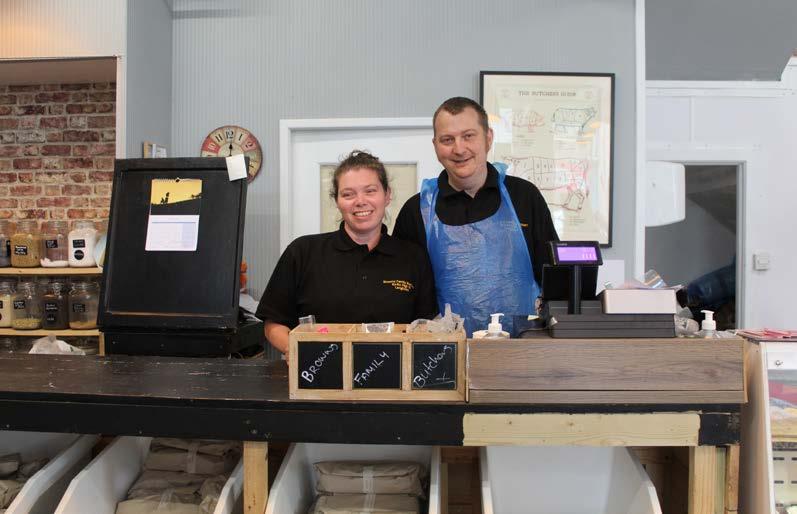

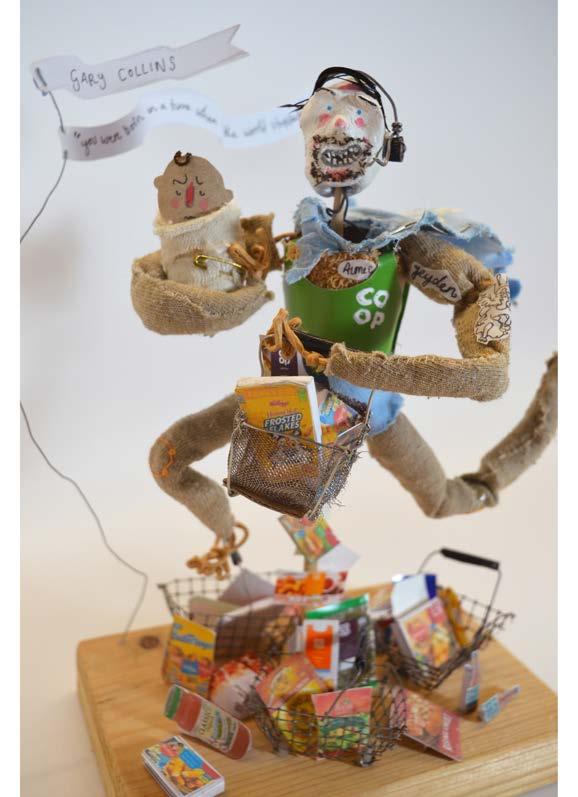

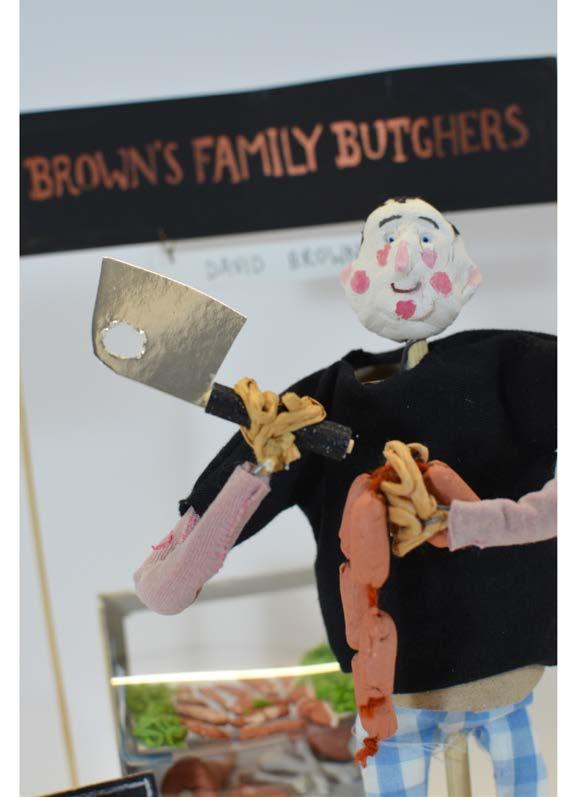


To encourage Langholm’s wider community to explore their artistic interests, and develop new portraiture skills and understandings, over summer 2021, OutPost Arts faciliated a series of free, accessible community activities.
An evening ‘In Conversation With’ live zoom event invited two local professional creatives - Illustrator Dwayne Bell & Fine Artist Philip Gunn to discuss their own practises, explain their processes, and share their portraiture influences.
An online mask-making workshop with commissioned artist Emily Tough focused on engaging the imagination of pre-school children and families. A live zoom portraiture workshop for adults was led by the project’s co-ordinator, Lucy MacLeod.
Lastly, a community portraiture competition with cash prizes was opened for entries from three categories - 18+ adults, young people aged 11-17, and children aged 5-10 years old.
A jury consisting of creative professionals and representatives from two of the project’s supporters (Langholm Alliance and Holywood Trust) selected finalists and runners-up from the amazing entries. A shortlist were also featured in the project’s final exhibition, and used in marketing materials.
Top right: Fynn McVittie’s second place entry was utilised to advertise the exhibition
Right: Lucy MacLeod’s live zoom portrait drawing workshop

P118-132: Competition entries and winners with their portraits P133-144: Langholm People Project exhibition

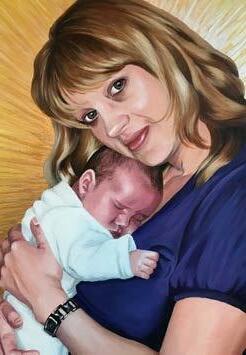
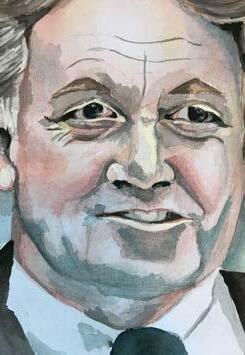
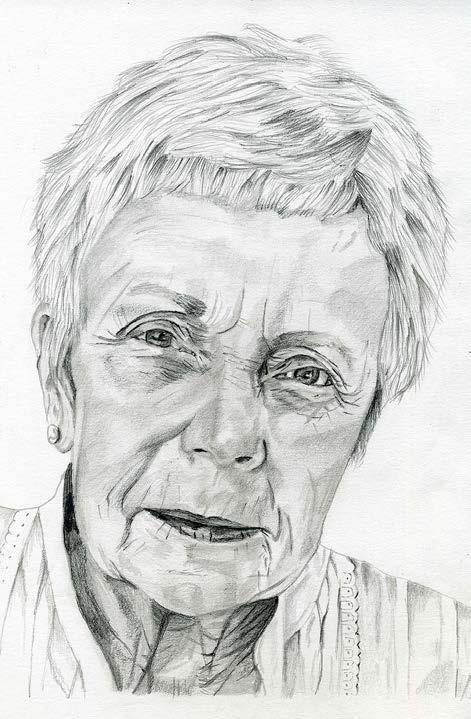
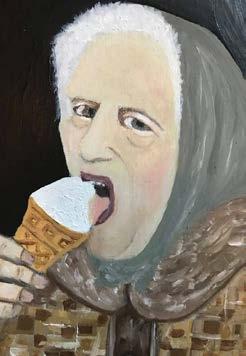


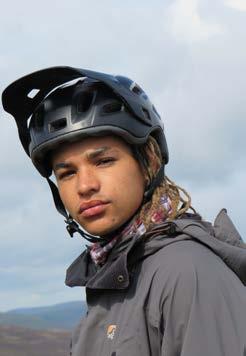
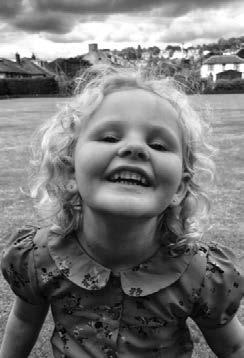
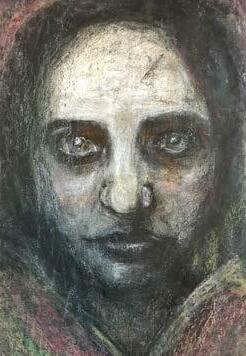
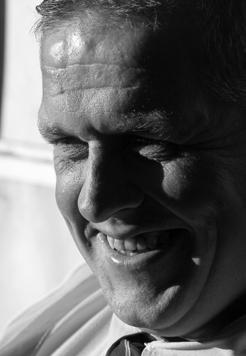

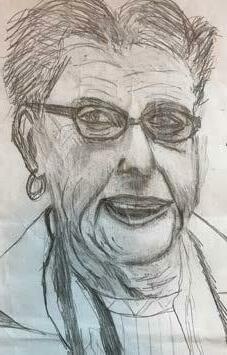


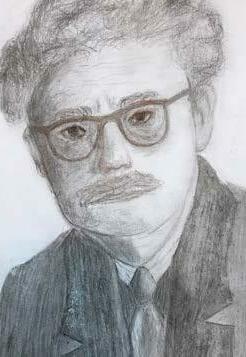

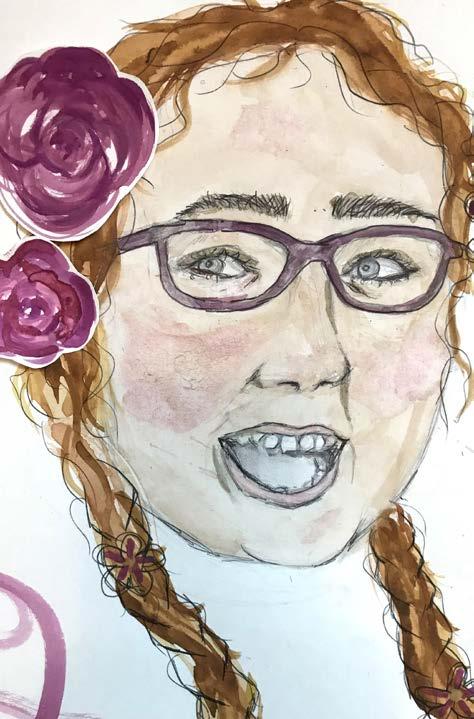

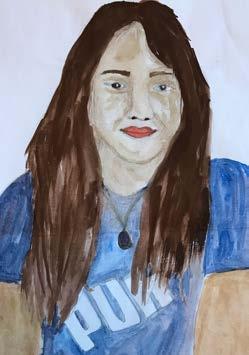

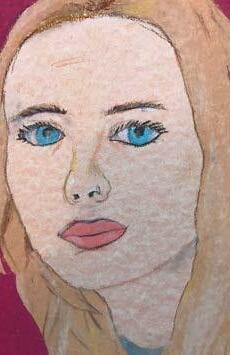





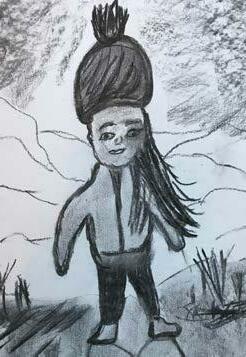

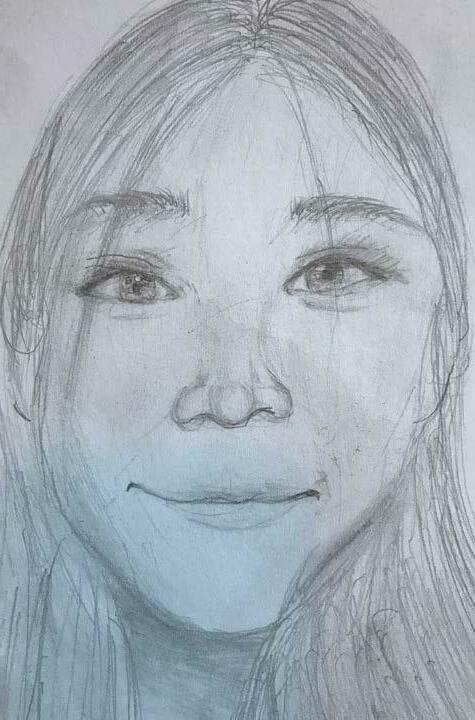




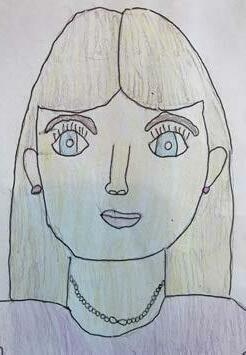
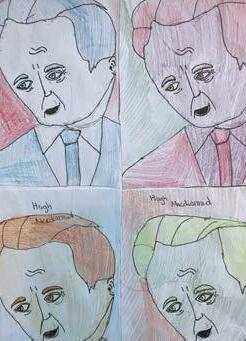
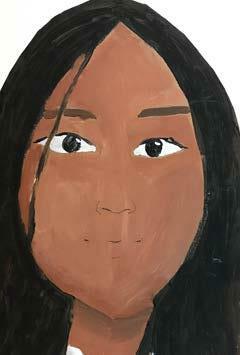

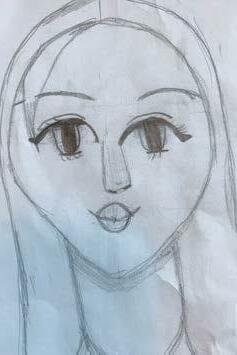



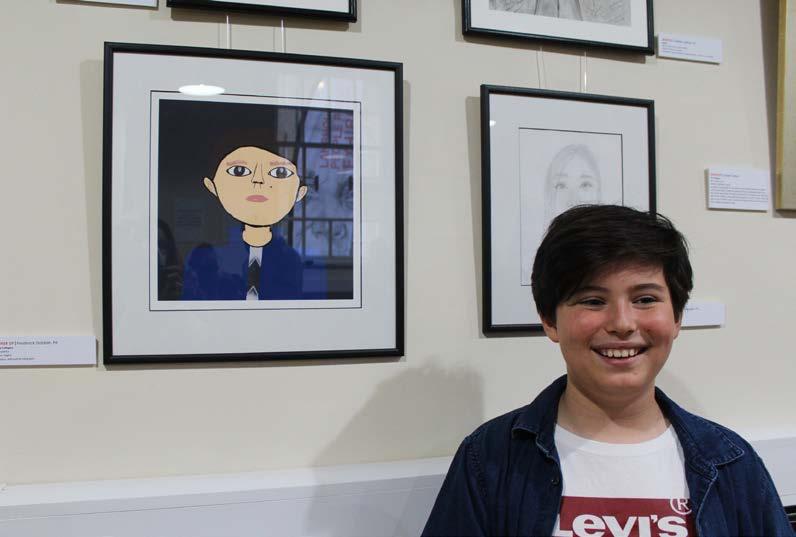
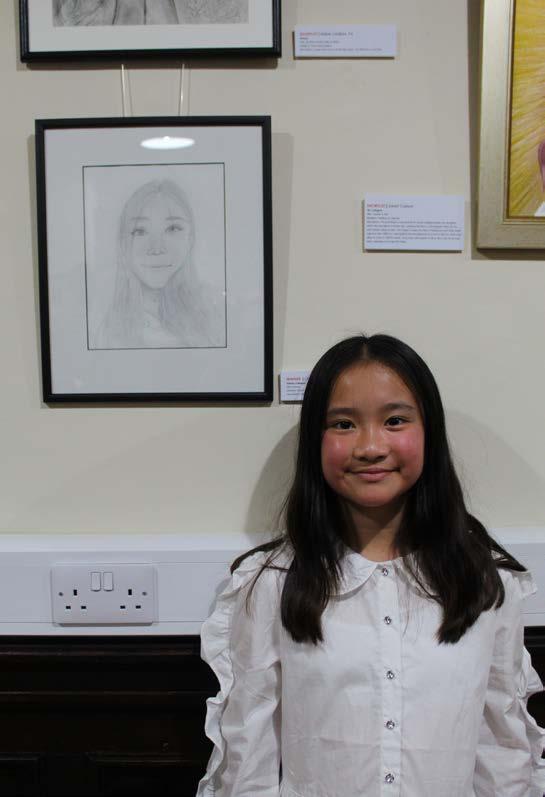 Primary Winner - Chanel Nguyen
Primary Winner - Chanel Nguyen
 Academy Runner-up - Fynn McVittie
Academy Runner-up - Fynn McVittie
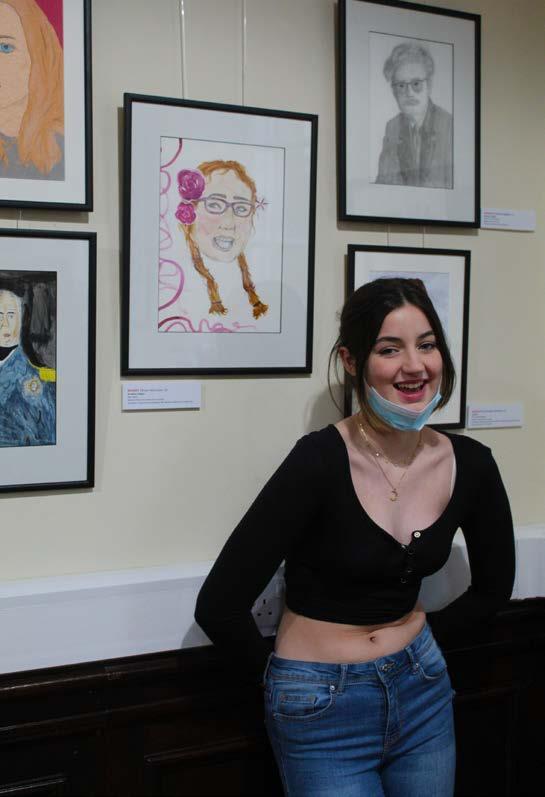 Academy Winner - Rose MacLeod
Academy Winner - Rose MacLeod
 Diane Hay - 18+ Runner-up
Diane Hay - 18+ Runner-up
 Sheila Sadler - 18+ Winner
Sheila Sadler - 18+ Winner
 Shortlisted Entry - David McVittie
Shortlisted Entry - David McVittie
 Photograph of Morag Eaton courtesy of Dave Watson
Photograph of Morag Eaton courtesy of Dave Watson

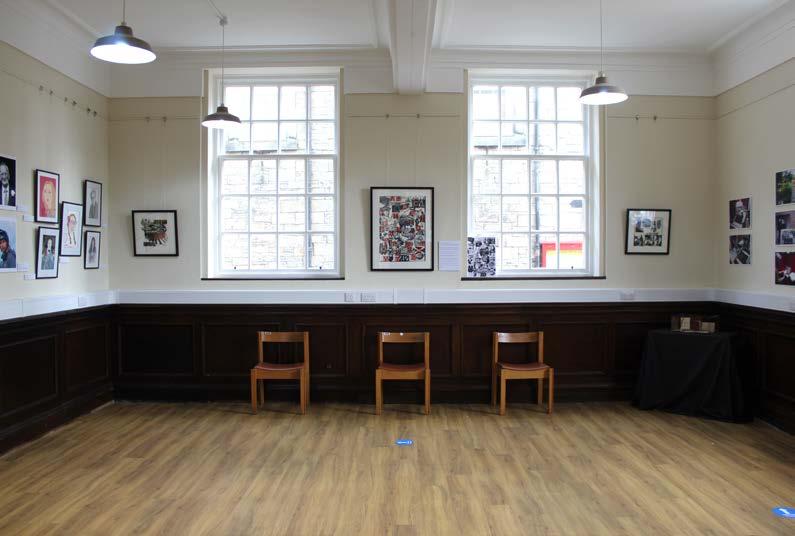
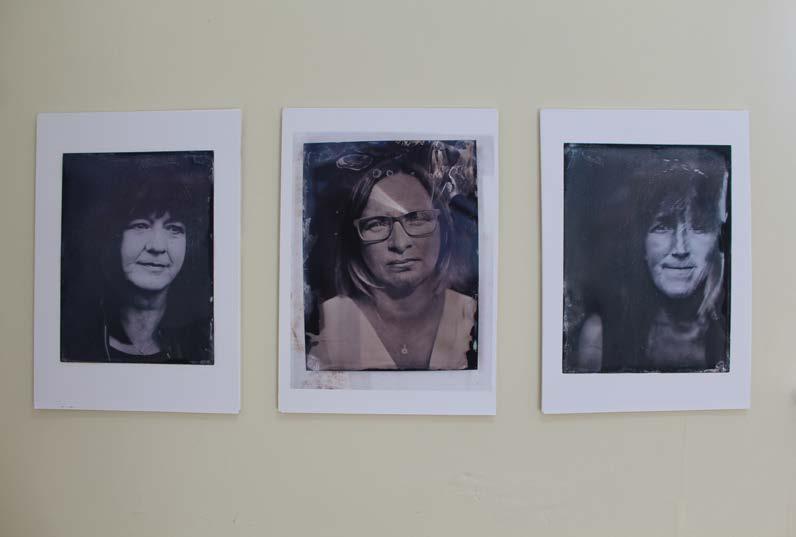
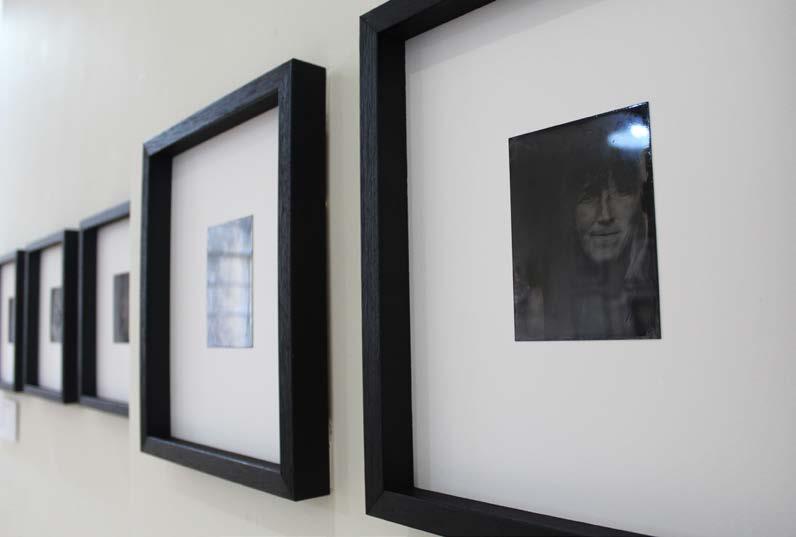

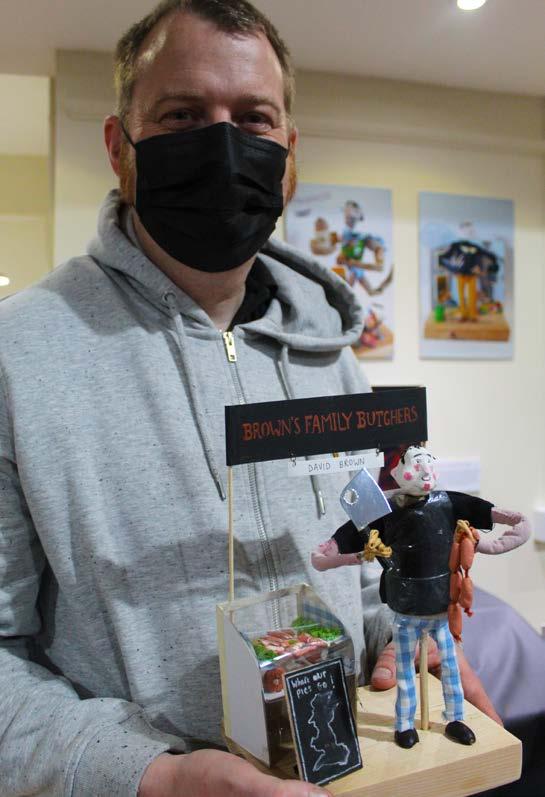
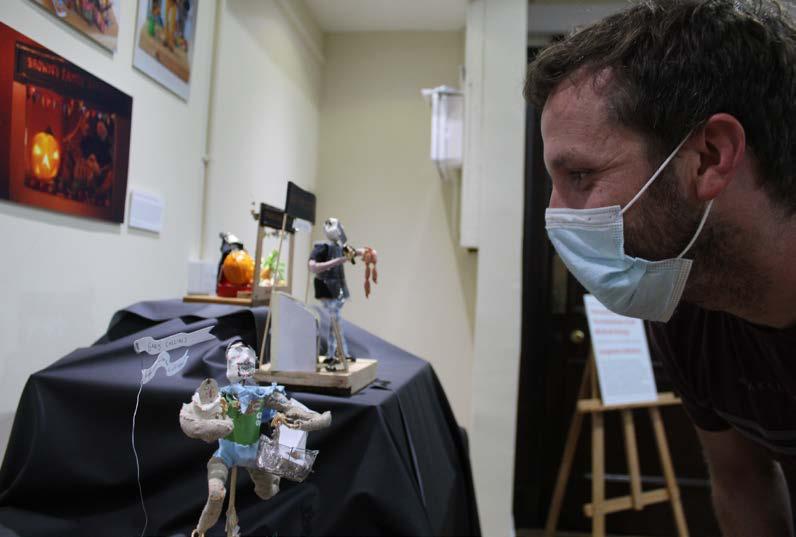

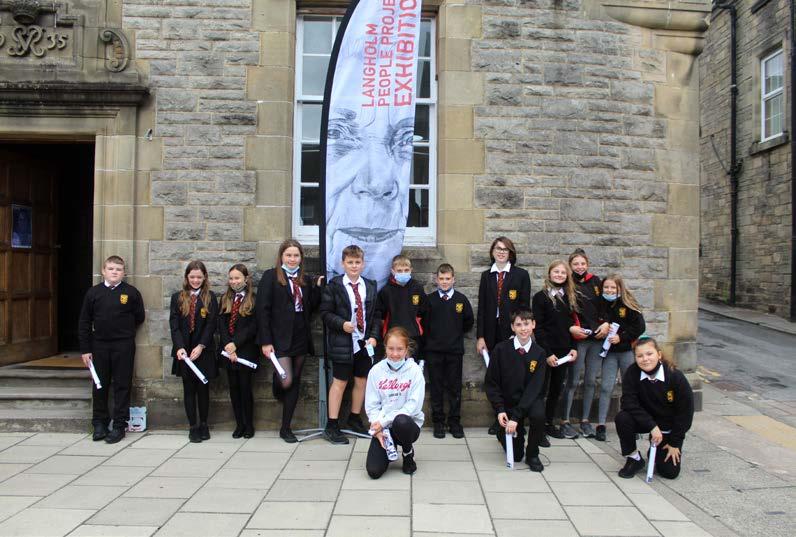

OutPost Arts would like to thank the following people, places and organisations whose support and contributions brought Langholm People Project to life:
• Artists Morag Eaton, Kyna Hodges & Emily Tough - for their skills, energy and enthusiasm
• Our Covid Heroes - for prioritising the needs of their community
• Research Lead, Sophie Jarzynafor going above and beyond to ensure the project was both accurate and meaningful
• To the descendents of the polish servicemen and locals who shared living memories of Langholm Camp and it’s residents - thank you for allowing us to access personal photography, momentos, documents and rich oral history - your contributions to this project are hugely appreciated
• Stephen Jarzyna - for the informative and engaging tour of Langholm Camp
• Stuart Tedham - for support with historical information and imagery
• Eskdale & Liddesdale Advertiser - for access to the newspaper’s archives
• Langholm Primary & Academy School’s staff and pupils - for their support and creative engagement
• Everyone who took part in the portait competition and the judging panelClare Hanna, Nicol Nicolson, Sophie Jarzyna, Philip Gunn, Kate Knott and Jason Railton
• Dwayne Bell & Philip Gunn - for contributing their time and professional experience
• Walled Garden Arkleton - location of the Covid Caring Heroes photoshoot
• Leslie Murray, Piotr Piasta & soundscape artist Graham Kelly
Direct descendants: Angela Foster, Kathleen Baxter, Stella Tait, Steven Jarzyna, Sophie Jarzyna, Marie Ritchie; Stan & Mag Wilson, Anna Irving & Violet Brand
Living memories: Alex Weatherstone, Drew Weatherstone, Jackie Bell, Iain & Nessie Grant and Elaine Anderson
Lastly, many thanks for the continued support from our project’s wonderful funders - Langholm Alliance, Holywood Trust, The Robertson Trust and Muirhall Energy.

A portrait of Langholm’s community members, past & present, facilitated by OutPost Arts with support from Langholm Alliance, Holywood Trust, The Robertson Trust & Muirhall Energy
